ayala
belkis
choco
cobas
bedia
couceiro
diago
olazabal
escalona
mendive
ever
haiti
larrinaga
esquivel
marta maría
queneditt
lescay
douglas
lasseria
peña
clara
leandro
ocejo
montalvan
elio
julia
leonel
Lorem ipsum dolor sit amet, consectetur adipiscing elit.
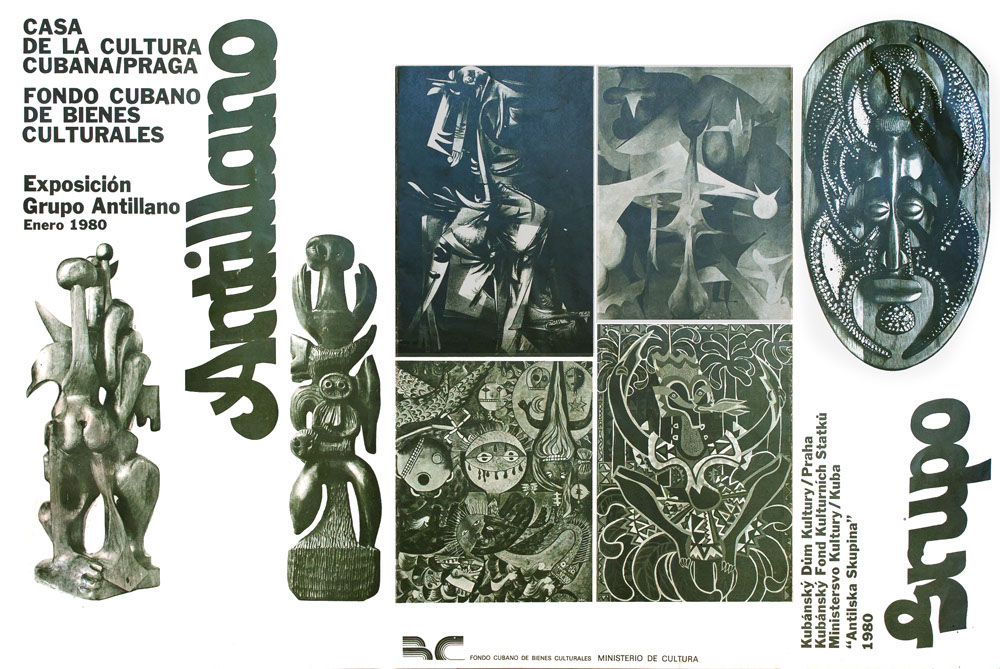
ESTEBAN AYALA
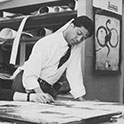
Esteban Ayala brought his experience as artistic director and designer to the exhibitions of Grupo Antillano. In enriching discussions he used to tell us about some of the European countries he had visited. He talked about literature and art and their cultural contexts, providing a sketch of his meetings with leading cultural figures he had occasion to meet.
When Ayala talked about France he would begin with the phrase: “...I saw the blue air of Paris...” and also mention “élan,” that metaphor about French culture referring to the City of Lights, as the center of the artistic avant-garde of the twentieth century.
In the history of Cuban graphic design Esteban Ayala’s work represents the transition and the fundamental connection between the approach to graphic design in the United States and the solid training in design that he received in Germany. In his own way he linked the classic European tradition to the dynamic modernism of North American graphic design.
Guillermina Ramos Cruz, 2012
Esteban Ayala aportó sus experiencias como director artístico y diseñador en los proyectos expositivos del Grupo Antillano. En un diálogo enriquecedor, nos hablaba acerca de alguno de los países europeos que él había visitado. Ayala hablaba sobre literatura, sobre el arte y los contextos culturales, realizando un bosquejo de los encuentros con destacadas personalidades de la cultura, que tuvo ocasión de conocer.
Cuando Ayala hablaba de Francia, comenzaba con su frase: “… yo vi el aire azul de París…” y también hacía alusión al “Elan,” esa metáfora sobre la cultura francesa, que hacía referencia a la atmósfera de la Ciudad-Luz, como el centro de la Vanguardia artística del siglo XX.
En la historia de la gráfica cubana, la obra de Esteban Ayala constituye el tránsito y el enlace fundamental entre las concepciones del diseño gráfico estadounidense y la sólida formación de diseño que recibió en Alemania, relacionando en su estilo la tradición clásica europea con la modernidad y la dinámica de la gráfica norteamericana.
Guillermina Ramos Cruz, 2012
BELKIS AYÓN MANSO
(b. 1967 – d. 1999 Cuba) graduada del Instituto
Superior de Arte, donde estudió técnicas de grabado y donde
enseñó más tarde. Hasta su muerte en 1999, presentó su trabajo
en exposiciones personales en la Phyllis Kind Gallery, Nueva
York; en la Couturier Gallery, Los Angeles (1998); en el Ludwig
Forum for International Art, Aachen, Alemania (1996); y en Galleria
Colorenero, Milan (1994). Participó en incontables exposiciones
colectivas en Cuba e internacionalmente, como la Bienal
de Venecia (1993); New Wave of Cuban Art – I, Tokyo (1997); y
Contemporary Art from Cuba: Irony and Survival on the Utopian
Island, ASU Art Museum (1998).
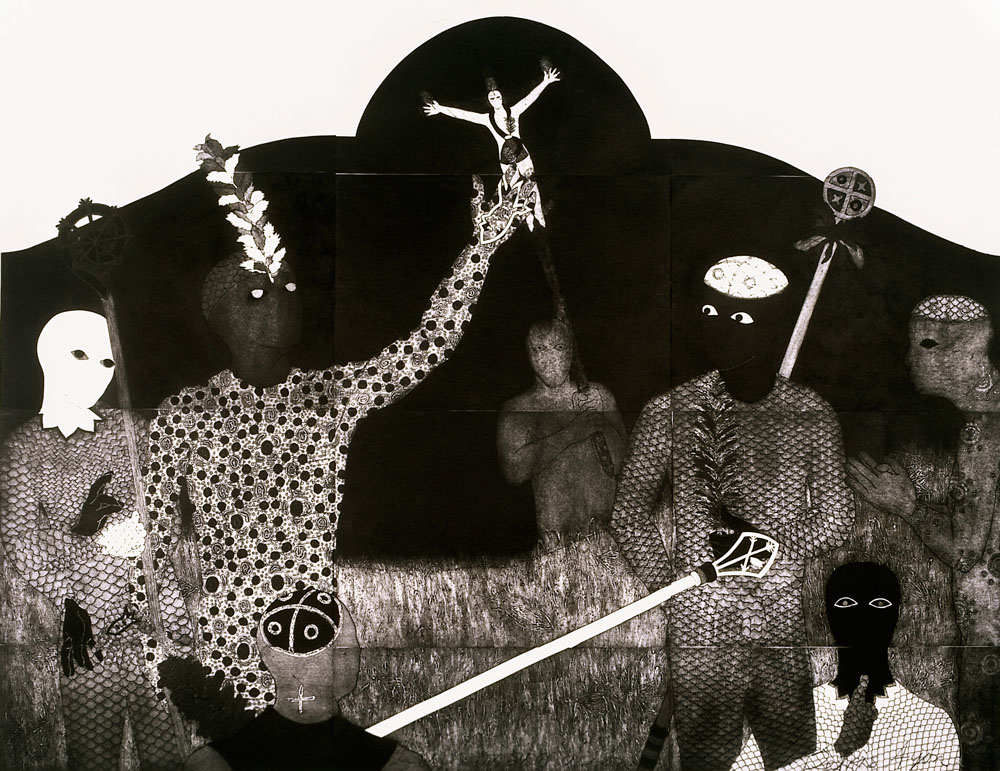
La consagración III, colograph / colografía, 12 pieces / 12 piezas, 207 x 303 cm, 1991
(b. 1967 – d. 1999) graduated from the Instituto
Superior de Arte, where she studied printmaking, later becoming
a professor of graphics there. Prior to her death in 1999, she
presented her work in solo exhibitions at the Phyllis Kind Gallery,
New York; and the Couturier Gallery, Los Angeles (1998); at the
Ludwig Forum for International Art, Aachen, Germany (1996);
and Galleria Colorenero, Milan (1994). She exhibited in many
group exhibitions in Cuba, as well as major international exhibitions
such as the Venice Biennial (1993); New Wave of Cuban
Art – I, Tokyo (1997); and Contemporary Art from Cuba: Irony
and Survival on the Utopian Island, ASU Art Museum (1998).
CHOCO (EDUARDO ROCA SALAZAR)
(b. 1949) es graduado de la Escuela
Nacional de Arte en La Habana en 1970. Un reconocido maestro en la técnica de grabado conocida como colografía, Choco ha participado en numerosas exposiciones personales y colectivas alrededor del mundo, en Japón, Puerto Rico, México, España,
Colombia, los Estados Unidos, Suecia y Angola, además de Cuba.
Recibió el Primer Premio de Grabado en el Salón Nacional de Artes Plásticas en La Habana en 1981 y el Gran Premio de la Trienal de Kochi, Japón, en 1999. Entre sus exposiciones recientes se encuentra una muestra individual en la Chambers Gallery de Londres (2007) y Retazos del Sol en Multicultural Arts Center (Cambridge, MA, 2012).

Te estoy mirando, mixed on canvas / mixta sobre tela, 117 x 83 cm, 2011
(b. 1949) graduated from the Escuela
Nacional de Arte in Havana in 1970. A master in the printmaking technique of collagraph, Choco has participated in solo and collective shows around the world, in Japan, Puerto Rico, Mexico, Spain, Colombia, the United States, Sweden, and Angola, in addition to Cuba. He received the Printmaking Award from the Salón Nacional de Artes Plásticas in Havana in 1981 and the Great Prize in the Triennial of Kochi, Japan, in 1999.
Recent exhibits include a solo exhibit at Chambers Gallery in London (2007) and Retazos del Sol (Traces of the Sun) at the Multicultural Arts Center (Cambridge, MA, 2012).
ROGELIO RODRIGUEZ COBAS

Instrumento musical, 1978. Photo / foto: Wilberg Hernández Monterde
La escultura de Cobas, maderas ensambladas con piezas metálicas de extracción fabril –tornillos, pistones, ruedecillas. . .- sobrepasan su primaria significación mito – religiosa y la inherente connotación erótica de sus formas, para entregarse como maquinarias carentes de función pero portadoras de un aviso sin caducidad: la indisoluble conexión de la criatura humana con la naturaleza y con la de su propio cuerpo en la entrada a la era de la robótica y la digitalización.
Pedro de Oraá, 2008
En la última entrevista que Lino Betancourt le hiciera Wifredo Lam, este afirmó que en los últimos años Cuba había dado dos grandes escultores africanistas: Agustín Cárdenas y Cobas.
Walterio Carbonell, 1988
Cobas’s sculptures, wood assemblages with manufactured metallic pieces such as screws, pistons, and little wheels... go beyond their first mythical-religious meaning and the inherently erotic connotation of their shapes. They become machines without function but which convey a timeless warning: the indissoluble connection between human beings and nature and with their own bodies on the threshold of the era of robotics and digitization.
Pedro de Oraá, 2008
In Lino Betancourt’s last interview with Wifredo Lam, Lam stated that in the last few years Cuba had given rise to two great African- ist sculptors: Agustín Cárdenas and Cobas.
Walterio Carbonell, 1988
JOSE BEDIA
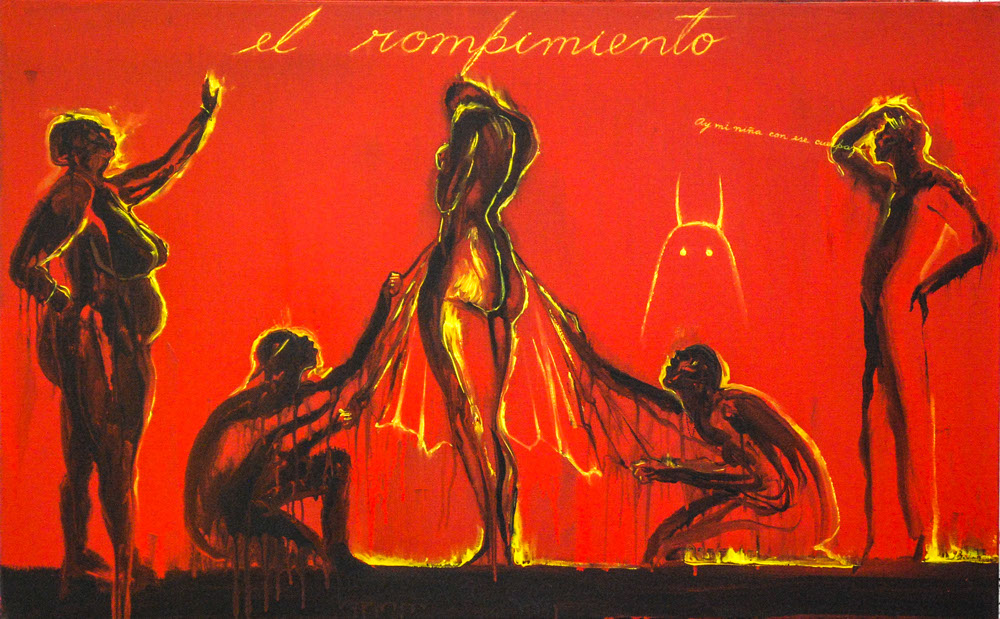
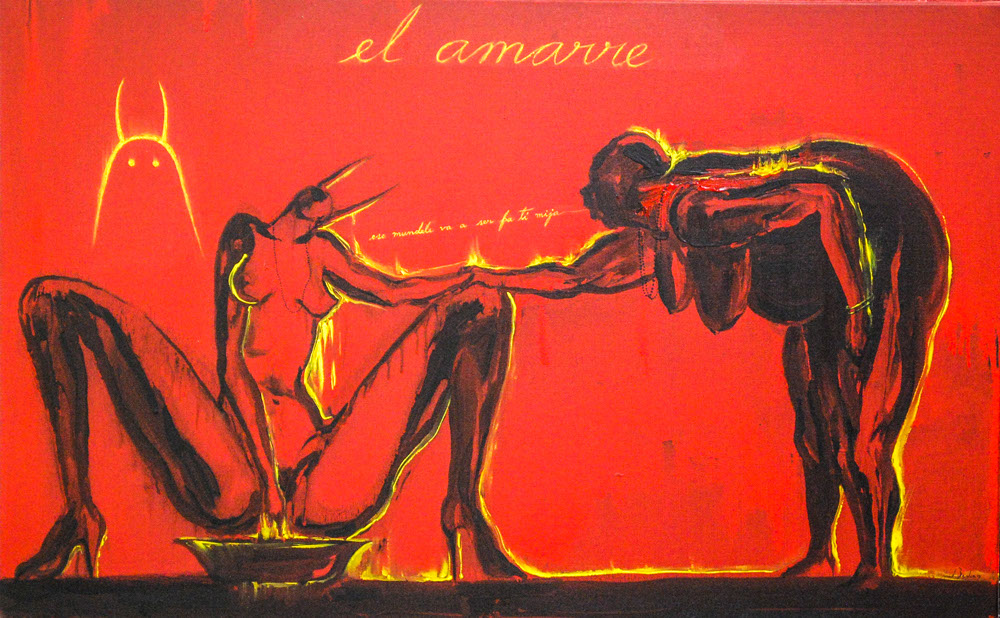
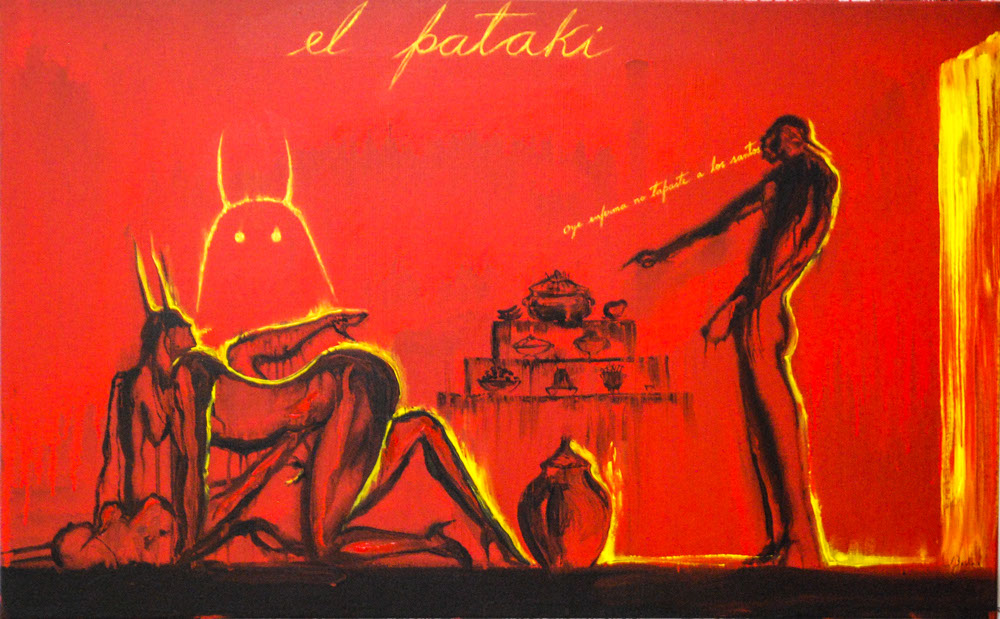



(b. 1959) es graduado de la Academia de Artes Plásticas “San Alejandro” y el Instituto Superior de Arte. Participó en la famosa exposición Volumen Uno en La Habana (1981) y en varias de las Bienales de La Habana de los ochenta. En 1989 fue seleccionado para participar en la exposición Magiciens de la terre, en el Centre Georges Pompidou en París. En 1994, el Institute of Contemporary Art, University of Pennsylvania, Philadelphia, organizó una retrospectiva del artista. El Centro Atlántico de Arte Moderno en Las Palmas, Islas Canarias, organizó otra retrospectiva en el 2011. Entre sus exposiciones recientes están
Without Masks (Johannesburg Art Gallery, 2010) y Transcultural
Pilgrim: Three Decades of Work by José Bedia, Fowler Museum, UCLA (2011-12).
(b. 1959) graduated from the Academia de Artes
Plásticas “San Alejandro” and the Instituto Superior de Arte.
He participated in the famous Volumen Uno exhibit in Havana
(1981) and in the Havana Biennials of the 1980s. In 1989 he
was selected for the exhibition Magiciens de la terre, held at
the Centre Georges Pompidou in Paris. In 1994, the Institute
of Contemporary Art, University of Pennsylvania, Philadelphia,
organized a retrospective of the artist. Another retrospective was
organized in 2011 by the Centro Atlántico de Arte Moderno in
Las Palmas, Canary Islands. Recent exhibitions include Without
Masks (Johannesburg Art Gallery, 2010) and Transcultural Pilgrim:
Three Decades of Work by José Bedia, Fowler Museum,
UCLA (2011-12).
MANUEL COUCEIRO PRADO

Title and date unknown / título y fecha desconocidos, oil on canvas / óleo sobre tela, 107 x 152 cm
(La Habana, 1923-1981): su labor pictórica tuvo como motivo principal la representación de lo cubano. Desde el inicio de su creación Couceiro reflejó uno de los sustratos conceptuales de nuestra cultura, la cual fue desplegada paralelamente a su intensa trayectoria vital, signada por el activismo cultural desde la FEU (Federación Estudiantil Universitaria) en la cual laboró activamente en la organización de los Festivales de Arte Universitarios. En su quehacer político trabajó en labores llevadas a cabo en los Estados Unidos durante la clandestinidad, encaminadas a lograr el predominio de la ideología revolucionaria. Regresó a Cuba con el triunfo de la Revolución en 1959 y se volcó en labores de dirección en organizaciones políticas y de masas.
Couceiro fue miembro del Ejecutivo de la Asociación de Artes Plásticas de la Unión de Escritores y Artistas de Cuba, (UNEAC) durante los años setenta, cuando ocupaba el cargo de Presidente de la Asociación de Artes Plásticas el diseñador gráfico Félix Beltrán.
Guillermina Ramos Cruz, 2012
(Havana, 1923-1981): His painting was mainly dedicated to representing Cuban themes. From the beginning of his artistic work Couceiro reflected one of the conceptual sectors of our culture. It unfolded in tandem with his intense career, marked by cultural activism from his time in the Federation of University Students (FEU) in which he worked actively to organize the University Art Festivals. In his political activities he worked in exile in the United States to promote revolutionary ideology. He returned to Cuba with the triumph of the Revolution in 1959 and turned his energy to leadership in political and mass organizations
In the 1970s Couceiro was a member of the Executive Committee of the Association of Fine Arts of the Union of Cuban Writers and Artists (UNEAC), when the graphic designer Félix Beltrán was president of the Association.
Guillermina Ramos Cruz, 2012
ROBERTO DIAGO DURRUTI
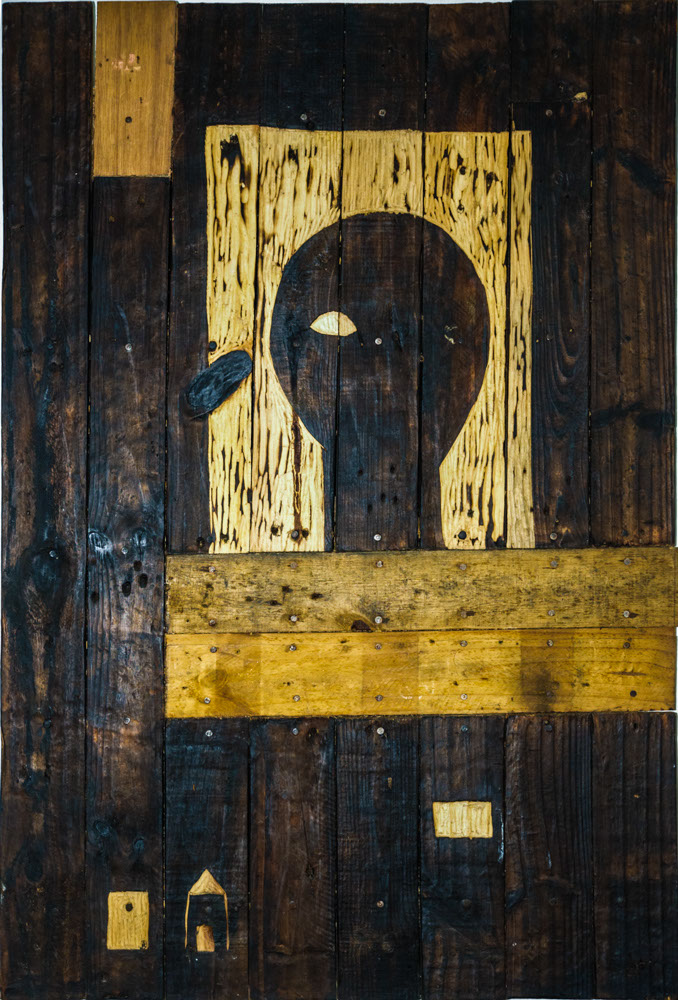
Yo soy monte, mixed on wood / mixta sobre madera, 120 x 80 cm, 2011
(b. 1971 Cuba) se graduó en la Academia de Artes Plásticas “San Alejandro” en 1990. Ha expuesto su obra de forma extensa en Cuba y en el resto del mundo, incluyendo exposiciones personales en la Galería Torco, Cantabria, España (2008); ARCO, Madrid; Brownstone Foundation, Paris, y Pan American Art Gallery, Dallas, TX (2005). Su obra ha sido incluida en exposiciones colectivas como Confluences: Inside, Contemporary Cuban Art, Zapopan Museum of Art, MAZ, Mexico (2007); Afrocuba: Works on Paper, 1968-2003, Lowe Art Museum, University of Miami, que ha recorrido el mundo. Ha recibido importantes premios incluyendo la Distinción por la Cultura Nacional del Ministerio de Cultura de Cuba (2002); y el Prix Amédée Maratier de la Fondation du Francais Judaism (1999) otorgado porprimera vez a un artista de América Latina. Diago participó en Queloides I (1997), en Without Masks (Johannesburg Art Gallery, 2010) y en Queloides: Race and Racism in Cuban Contemporary Art (2010-12).
(b. 1971) graduated from the Academia de Artes Plásticas “San Alejandro” in 1990. He has exhibited his work extensively in Cuba and throughout the world, including in solo exhibitions at the Torco Gallery, Cantabria, Spain (2008); ARCO, Madrid, Brownstone Foundation, Paris, and the Pan American Art Gallery, Dallas, TX (2005). His work has been included in group exibitions: Confluences: Inside, Contemporary Cuban Art, Zapopan Museum of Art, MAZ, Mexico (2007); Afrocuba: Works on Paper, 1968-2003, organized by the Lowe Art Museum, University of Miami, which traveled throughout the world. He has received important prizes including an award of Distinction from the Cuban Ministry of Culture (2002); the Prix Amédée Maratier from the Fondation du Francais Judaism (1999) awarded
for the first time to a Latin American artist. Diago participated in Queloides I (1997), in Without Masks (Johannesburg Art Gallery,
2010), and in Queloides: Race and Racism in Cuban Contemporary
Art (2010-12).
SANTIAGO RODRIGUEZ OLAZABAL
(b. 1955) estudió en la Academia de
Artes Plásticas “San Alejandro” en los setenta, pero no se graduó. Olazábal ha dedicado su arte a celebrar la religiosidad Afrocubana y en especial la Regla de Ocha o Santería. Un miembro de la llamada generación artística de los ochenta, ha participado en exposiciones individuales y colectivas en Cuba, México, los Estados Unidos, Italia, Alemania, Brasil, Francia, Holanda, España, Haití, y Canadá. En el 2005 el Museo Nacional de Bellas Artes presentó su exposición individual Onile, El espítitu sagrado de la tierra. Entre sus exposiciones recientes se encuentra Recent
Contemporary Caribbean Art, Brooklyn Museum, Brooklyn (2008) y National Black Fine Art Show, The PuckBuilding, SoHo, Nueva York (2007-09).
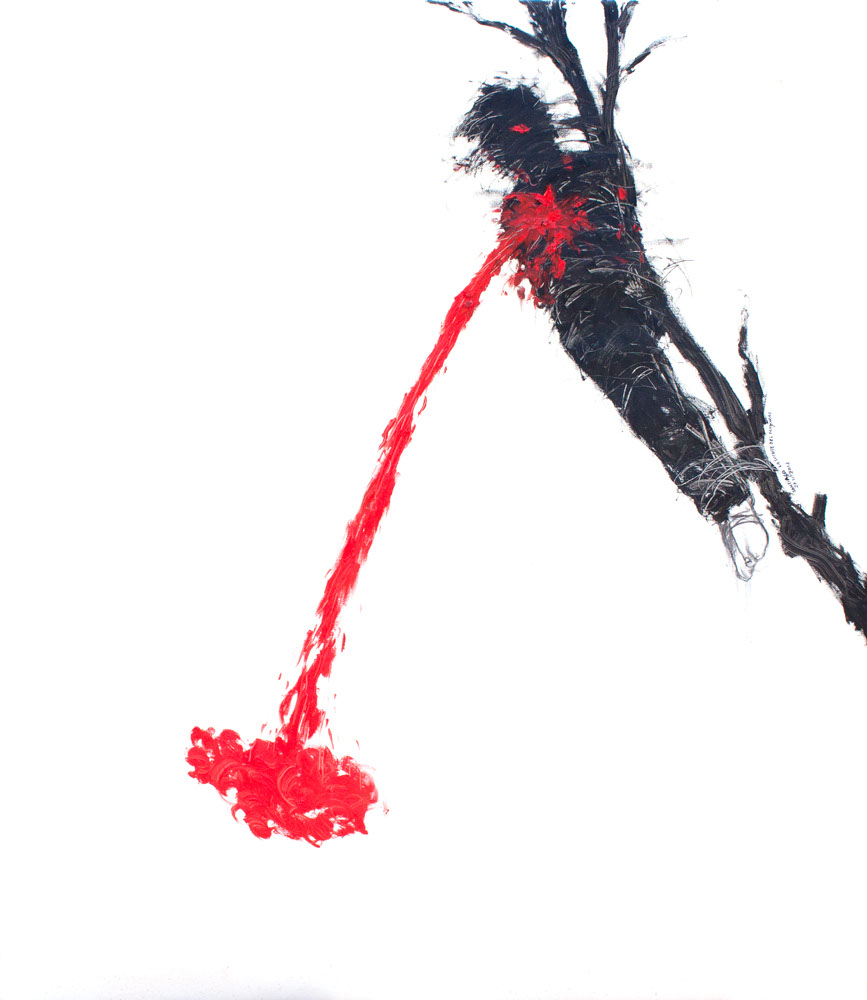
La suerte del mayoral, charcoal, synthetic enamel, oil bar on canvas / carboncillo, esmalte sintético, óleo barra sobre lienzo, 150 x 130.5 cm, 2012
(b. 1955) studied at the Academia
de Artes Plásticas “San Alejandro” in Havana in the 1970s, but did not graduate. Olazábal has devoted his art to celebrate Afro-Cuban religiosity, in particular the Reglad de Ocha or Santería. An artist of the iconoclastic generation of the 1980s, he has participated in solo and collective exhibits in Cuba, Mexico, the United States, Italy, Germany, France, Netherlands, Spain, Haiti,
Brazil, and Canada. In 2005 his solo exhibit, Onile, El espítitu sagrado de la tierra, was hosted by the Museo Nacional de Bellas Artes in Havana. Recent exhibits include Infinite island, Contemporary Caribbean Art, Brooklyn Museum, Brooklyn (2008) and
National Black Fine Art Show, The PuckBuilding, SoHo, New York (2007-09).
HERMINIO ESCALONA GONZALEZ
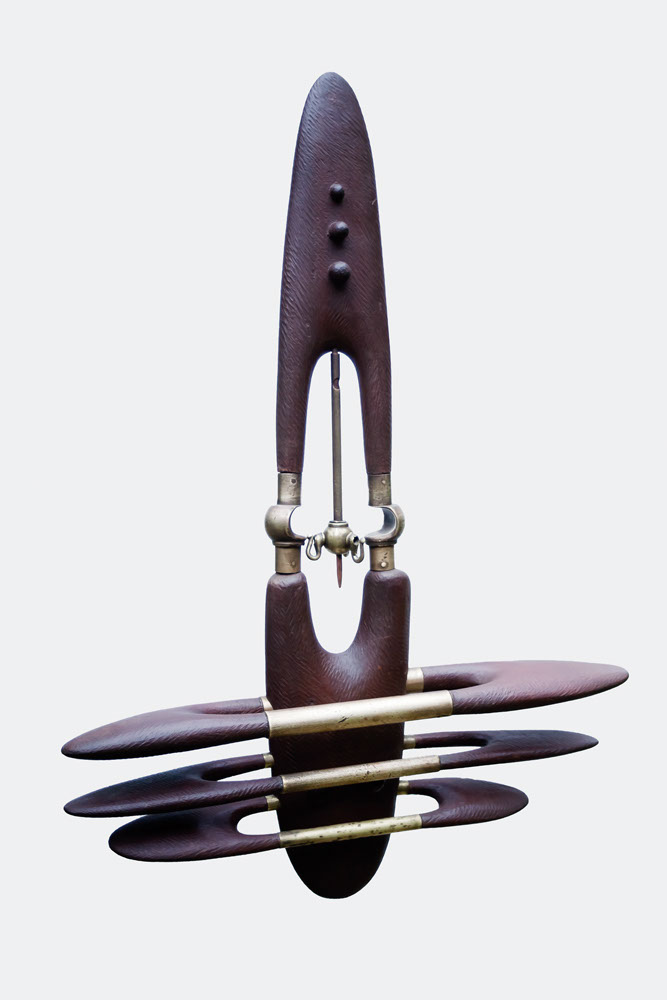
Virgen, acana and bronze / ácana y bronce, 79 x 57 x 12 cm, 1997. Photos/fotos: Madeline Martinez
(Guaímaro, Camagüey, 1944). Cursó estudios en la Escuela de Artes Plásticas “José Martí” en Camagüey, así como en la Escuela Juan Fornet Piña, en Holguín.
En su creación escultórica Escalona ha desarrollado diferentes líneas estilísticas, una dedicada a la madera tallada, inspirada en el repertorio de imágenes pertenecientes a la cultura taína; y otra en sus trabajos en metal donde la soldadura en alambrón define las formas en las cuales la figura humana estilizada constituye uno de los aspectos temáticos principales.
A través de toda su trayectoria artística Escalona ha realizado escultura conmemorativa de temática histórica, además de esculturas ambientales las cuales han sido emplazadas en diversas ciudades de Camagüey y en la zona oriental de Cuba. Escalona ha realizado exposiciones personales en diversas universidades y centros culturales de los Estados Unidos y América Latina.
Guillermina Ramos Cruz, 2012
(Guáimaro, Camagüey, 1944) studied at the José Martí School of Fine Arts in Camagüey, and in the Juan Fornet Piña School in Holguín.
In his sculpture Escalona has developed different stylistic lines, one of which is dedicated to carved wood, inspired by the repertory of images
from Taino culture, and another in his work in metal where welding defines the forms in which the stylized human figure is one of the main themes.
Throughout his artistic career Escalona has done commemorative sculpture on historic topics, as well as environmental sculptures that have been placed in several cities in Camagüey and other parts of eastern Cuba. Escalona has had one-person shows in several universities and cultural centers in the United States and Latin America.
Guillermina Ramos Cruz, 2012
MANUEL MENDIVE HOYO
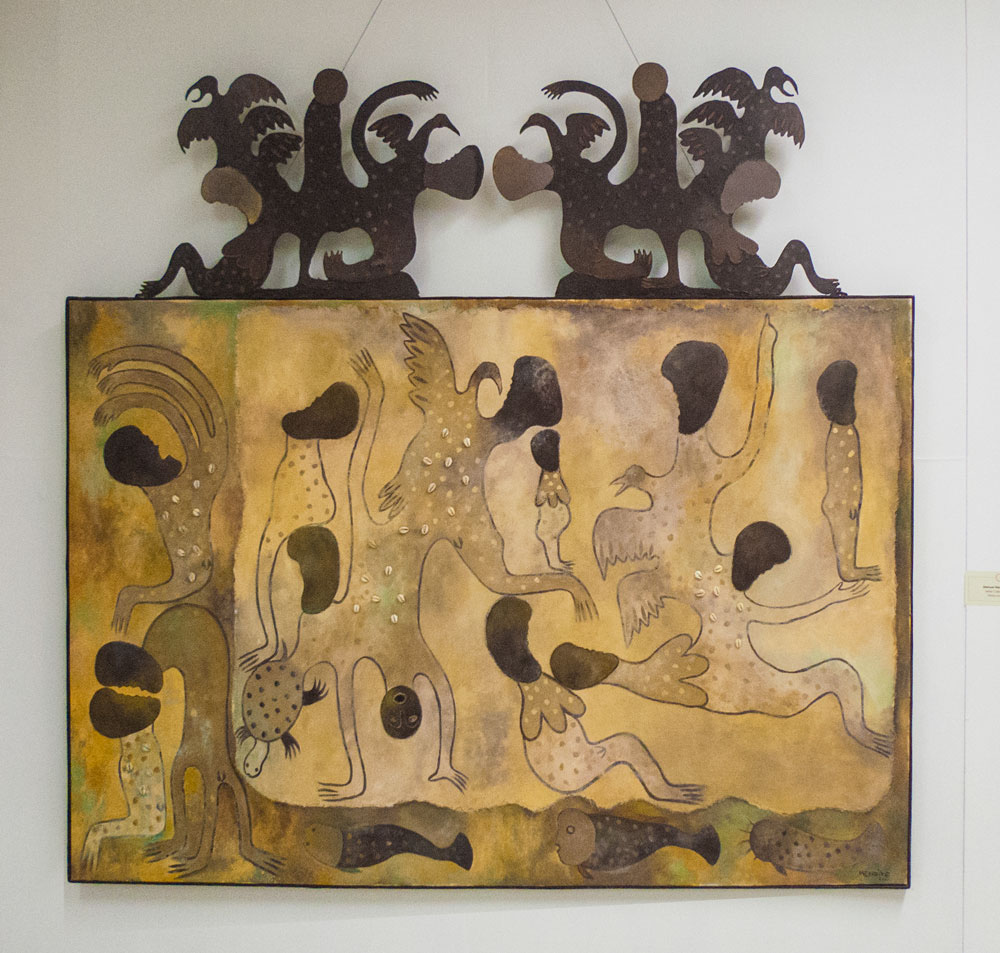
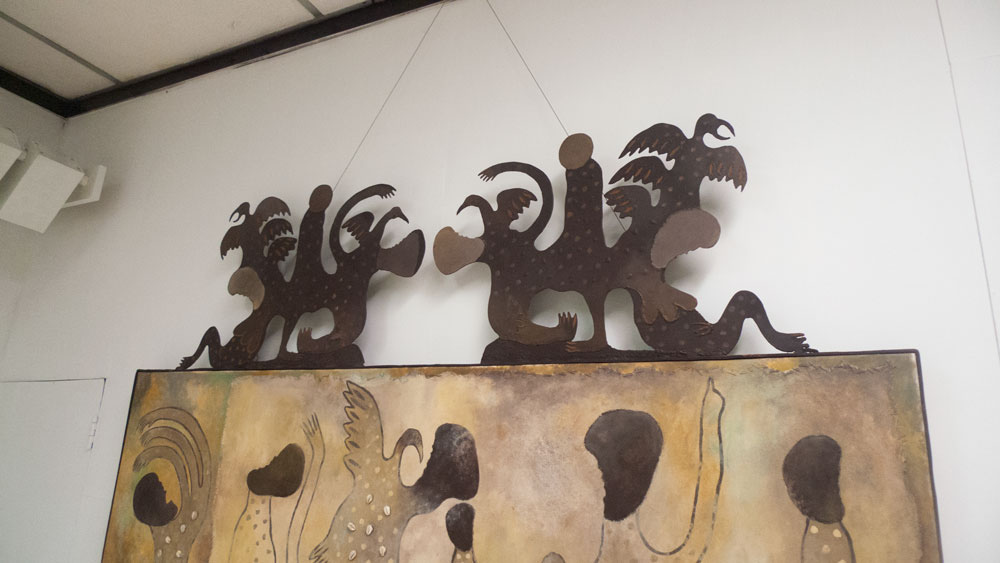


(La Habana, 1944) quiso representar desde su infancia el mundo que le rodeaba, descubrió su entorno familiar por el aliento de su madre y percibió imágenes pertenecientes a la religiosidad popular y al sincretismo religioso afrocubano. Se graduó en la Escuela de Artes Plásticas San Alejandro en el año 1963, y un año más tarde presenta su primera exposición personal. El análisis de su obra nos conduce al estudio de una iconografía en la cual afloran los símbolos surgidos de la representación plástica de los orichas. En la década de los años sesenta inició la recreación de los Patakis de la religión yoruba, mediante los cuales plasmó el sentido primigenio, de revelación, a través de pinturas, sobre madera, creó sus propios símbolos, evocando las representaciones arcaicas de los orichas y su noción principal con el sentido primigenio de cada figura.
(Havana, 1944) from the time he was a child wanted to represent the world around him. He discovered the family circle with his mother’s encouragement and saw images from popular religions and Afro-Cuban religious syncretism. He graduated from the San Alejandro School of Fine Arts in 1963, and a year later had his first one-person exhibition. The analysis of his work leads us to study an iconography in which the symbols arising from the artistic representation of the orichas come forth. In the 1960s he began to reproduce the stories of Yoruba religion, through which he conveyed an original sense of revelation. Through his paintings on wood he created his own symbols, evoking the archaic representations of the orichas and their main idea together with the original sense of each figure.
EVER FONSECA
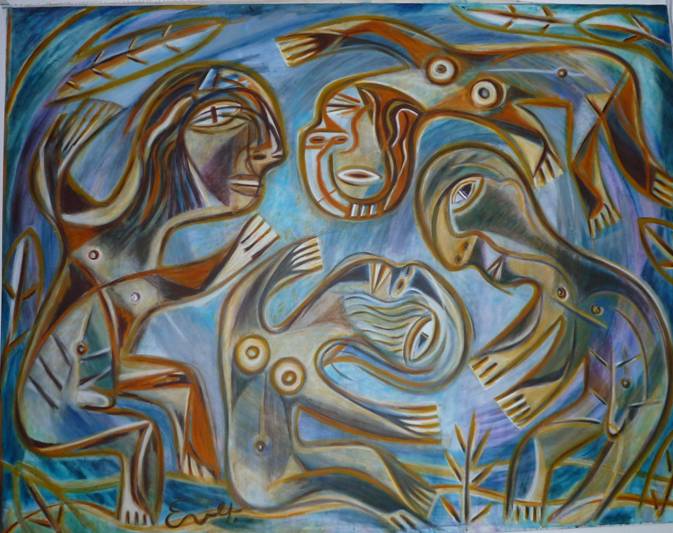
Proveniente de las zonas rurales de la región oriental de Cuba, Ever Fonseca Cerviño (Guantánamo, 1938) llega a La Habana para estudiar en la Escuela Nacional de Artes Plásticas (ENA) en Cubanacán. Eufórico, pleno de sus vivencias familiares y de los personajes simbólicos que habitaban el paisaje cubano, escenario de múltiples leyendas campesinas, Ever Fonseca comenzó a pintar grandes lienzos desbordando el caudal imaginativo y tenaz proveniente de lo más profundo de la simiente de su tierra.
Desde la primera etapa de su obra, sus pinturas, realizadas en óleo sobre lienzo, reflejaban las confluencias culturales que tuvieron lugar en el contexto antillano por la referencia a leyendas, donde conviven el güije o jigüe quienes son identificados como personajes nocturnos que emergen de los ríos, las anécdotas de carácter popular, las prácticas de creencias religiosas así como la historia local; surgieron en lo profundo de la vida del campesino cubano.
Guillermina Ramos Cruz, 2012
(Guantánamo, 1938) who hails from the rural areas of eastern Cuba, came to Havana to study in the National School of Fine Arts (ENA) in Cubanacán.
Always upbeat, imbued with family connections and the symbolic characters that lived in the Cuban land- scape, the source of many legends of the country people, Ever Fonseca began to paint large canvasses overflowing with the tenacious and imaginative stream coming up from the deepest roots of his land.
From the first phase of his work his paintings, done in oil on canvas, reflected the cultural confluences in the Antillean context, with references to legends where the güije or jigüe lives, those nocturnal beings that emerge from the rivers, the popular stories, the practice of religious beliefs or local history. They came up from the depths of the lives of Cuban country people.
Guillermina Ramos Cruz, 2012
RAMON HAITI

El Gran Güije, 155 x 50 x 50 cm, 1978. Photo / foto: Wilberg Hernández Monterde
(...) Ramón Haití terminó los estudios de pintura en 1968 y los de escultura en 1969, en San Alejandro. Su obra numerosa y dispersa representa el quehacer artístico del cubano, en los países Escandinavos, Hungría, Alemania, donde obtuvo un segundo premio de Escultura en 1978, y recién se ha hecho acreedor de la Medalla de los 1300 Años de la Fundación de Bulgaria. Ha participado en exposiciones nacionales e internacionales y su obra ha sido siempre recibida con verdadero fervor. Sus piezas figuran en galerías y museos y forman parte de colecciones estatales y privadas, pues, ¿quién no desea la grata compañía?
Lázara Castellanos, 1985
(...) Ramón Haití finished his studies in painting in 1968 and in sculpture in 1969, in San Alejandro. His copious and widely dispersed work represents Cuban artistic activity in Scandinavia, Hungary, and Germany, where he won the second prize in sculpture in 1978. He recently won the Medal of 1300 Years since the Founding of Bulgaria. He has participated in Cuban and international exhibitions, and his work has always been received with genuine fervor. His pieces are in galleries and museums and both governmental and private collections. Who would not want such pleasant company?
Lázara Castellanos, 1985
ANDRES LARRINAGA
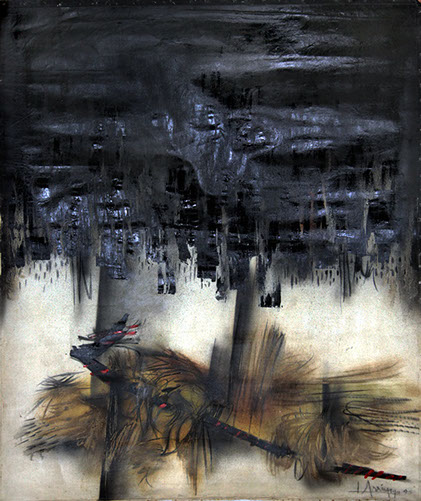
Güije de la noche, oil on canvas / óleo sobre tela, 120 x 100 cm, 1992
...uno de los más renombrados pintores cubanos contemporáneos... con un impresionante mundo interior y un lenguaje que parte de la identidad propia para alcanzar la universalidad.
diario ABC, Madrid, 2002
Su primera pintura ⎯ni negrista, ni afrocubana⎯ es únicamente cubana. Y lo es ⎯según la tesis de Ortiz⎯ por hechura y no por natura, dos categorías explicadas con cabal lucidez en su libro El engaño de las razas. Los elementos afroides, por aludirlos de alguna manera, que se aprecian más que nada en lo formal en la obra de Larrinaga, son el resultado de una “convivencia mental” con esos elementos.
(...) Larrinaga abstrae formas, suprime, esencializa, sin ser abstracto. En sus cuadros los misterios visuales del ámbito antillano se desplazan lentos o dan saltos como fugas gestuales que tornan al pintor en una especie de expresionista calibanesco, nada cartesiano.
Juan Sánchez, 1998
... one of the most renowned Cuban painters today... with an impressive interior world and an idiom that begins with his own identity and goes on to achieve universality.
ABC, Madrid, 2002
His early painting is neither black-focused nor Afro-Cuban, but just Cuban. And it is Cuban, following Ortiz’s thesis, by doing and not by nature, two categories Ortiz lucidly explains in his book El engaño de las razas. The African elements, to give them some sort of name, that can be seen mostly in the shapes in Larrinaga’s work, are the result of a “mental coexistence” with those elements.
(...) Larrinaga abstracts shapes, suppresses, essentializes, without being abstract. In his paintings the visual mysteries of the Antillean environment slowly shift to one side or leap away like gestural escapes that make the painter a sort of Calibanesque expressionist—nothing Cartesian about it.
Juan Sánchez, 1998
ALEXIS ESQUIVEL BERMUDES
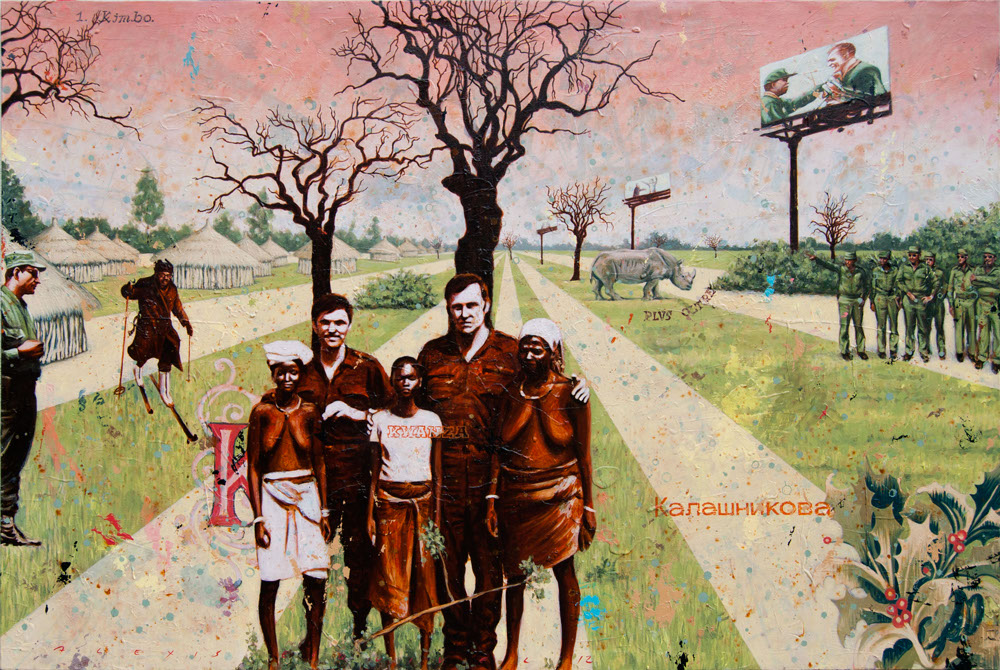
Postales de la guerra, acrylic on canvas / acrílico sobre tela, 130 x 195 cm, 2012
(b. 1968 Cuba) graduado de licenciatura en educación artística del Instituto Superior Pedagógico Enrique José Varona, La Habana. Ha expuesto frecuentemente, incluyendo exposiciones personales en el Museo del Ron (2006); Dudley House, Harvard University, Cambridge (2001) y M.A.R.S. Art Space, Phoenix, AZ (1998). Su obra también ha formado parte de Group Therapy, Galería Fernando Pradilla, Madrid (2008); Contemporary Cuban Art in the Faber Collection, Harn Museum of Art, University of Florida (2007); y Living for the City en el Centre International de Exposition de Larouche, Quebec. Ha sido un artista invitado en Tufts University, Boston, y en University of Georgia, Athens. Fue co-curador de Queloides I. Participó también en Ni Músicos ni Deportistas, Queloides II (1999), Without Masks (Johannesburg Art Gallery, 2010) y Queloides: Race and
Racism in Cuban Contemporary Art (2010-12).
(b. 1968) holds a Masters in art education from the Instituto Superior Pedagógico Enrique José Varona, Havana. He has exhibited widely including solo shows at Club Havana
Museo del Ron (2006); Dudley House, Harvard University, Cambridge (2001) and M.A.R.S. Art Space, Phoenix, AZ (1998). His work has been included in Group Therapy, Galleria Fernando
Pradilla, Madrid (2008); Contemporary Cuban Art in the Faber Collection, Harn Museum of Art, University of Florida (2007); and Living for the City at the Centre International de exposition de Larouche, Quebec. He has been a visiting artist at Tufts
University, Boston, and the University of Georgia, Athens. He co-curated Queloides I and participated as well in Ni Músicos ni Deportistas, and Queloides II (1999). Recent exhibits include Without Masks (Johannesburg Art Gallery, 2010), and Queloides:
Race and Racism in Cuban Contemporary Art (2010-12).
MARTA MARÍA PEREZ BRAVO
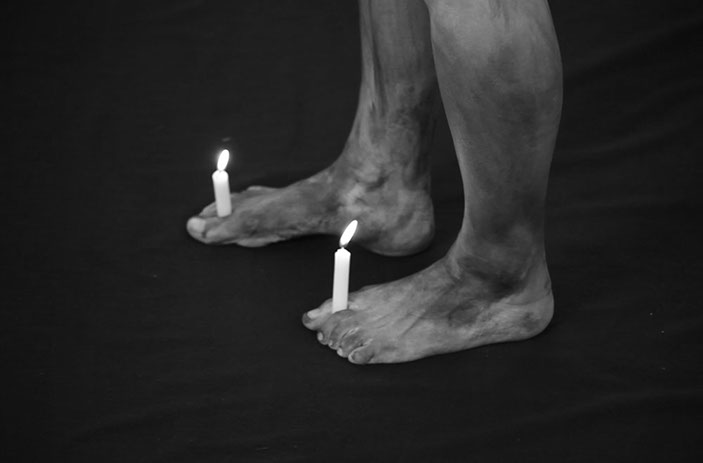
Un camino oscuro, video, 1.30 min., 2011
(b. 1959 Cuba) estudió en el Instituto Superior de Arte y en la Academia de Artes Plásticas “San Alejandro,” ambas en la Habana. Su obra ha sido expuesta en una cincuenta exposiciones personales alrededor del mundo, incluyendo museos y galerías en Cuba, Finlandia, Alemania, Canadá, Colombia, México, España, Brasil, Italia y Venezuela. Su obra también ha formado parte de numerosas exposiciones colectivas, incluyendo la Tercera y Cuarta Bienal de la Habana; la Bienal de São Paulo (1990); la Bienal de Estambul (1997); y ARCO, Madrid (1997 al 2005). Participó en Without Masks (Johannesburg Art Gallery, 2010) y en Queloides: Race and Racism in Cuban Contemporary Art (2010-12).
(b. 1959) studied at the Instituto Superior de Arte and later at the Academia de Artes Plásticas “San
Alejandro,” both in Havana. She has had nearly fifty solo exhibitions
around the world, including museum and gallery shows in Cuba, Finland, Germany, Canada, Colombia, Mexico, Spain, Brazil, Italy, and Venezuela. Major group exhibitions include the
Havana Biennials III and IV; São Paulo Biennial (1990); Istanbul Biennial (1997); and ARCO, Madrid (1997 through 2005). Recent exhibits include Without Masks (Johannesburg Art Gallery,
2010), and Queloides: Race and Racism in Cuban Contemporary Art (2010-12).
RAFAEL QUENEDITT MORALES
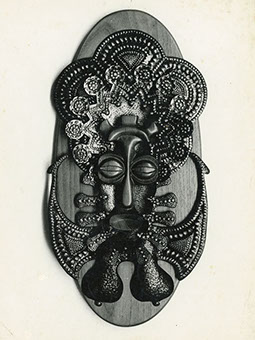
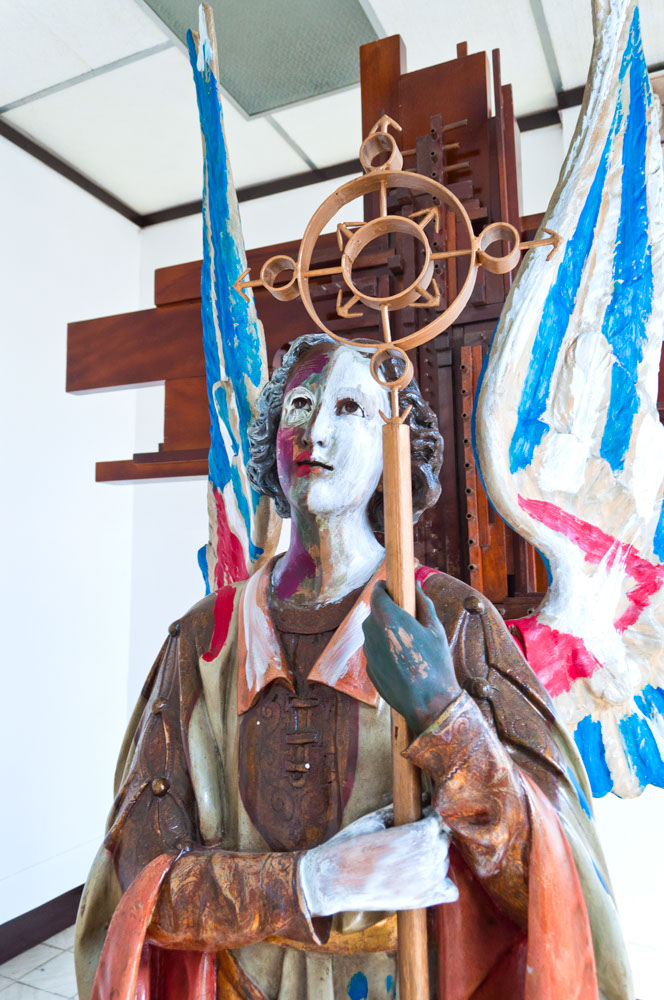
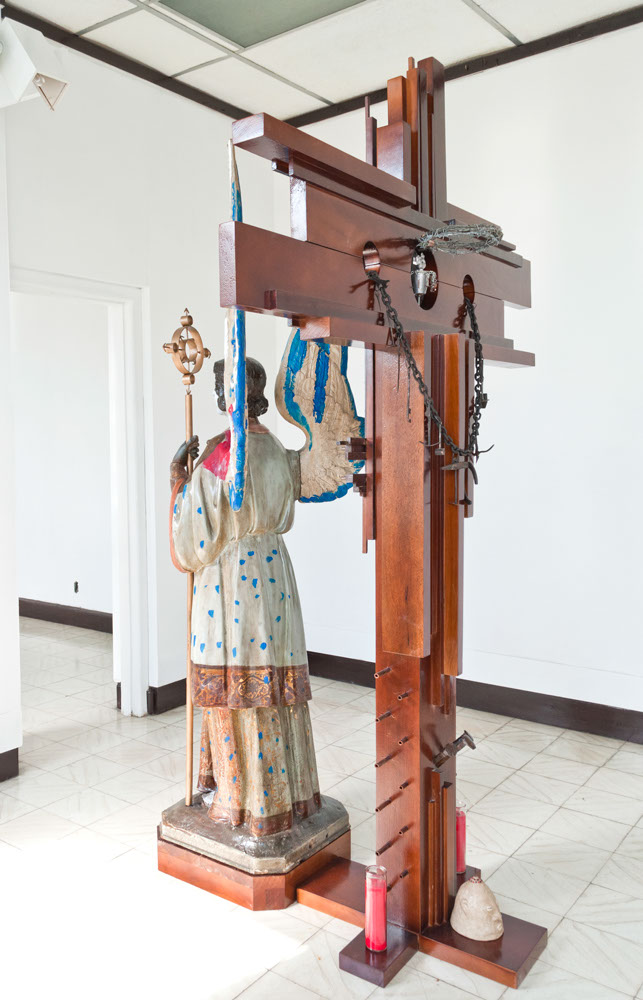
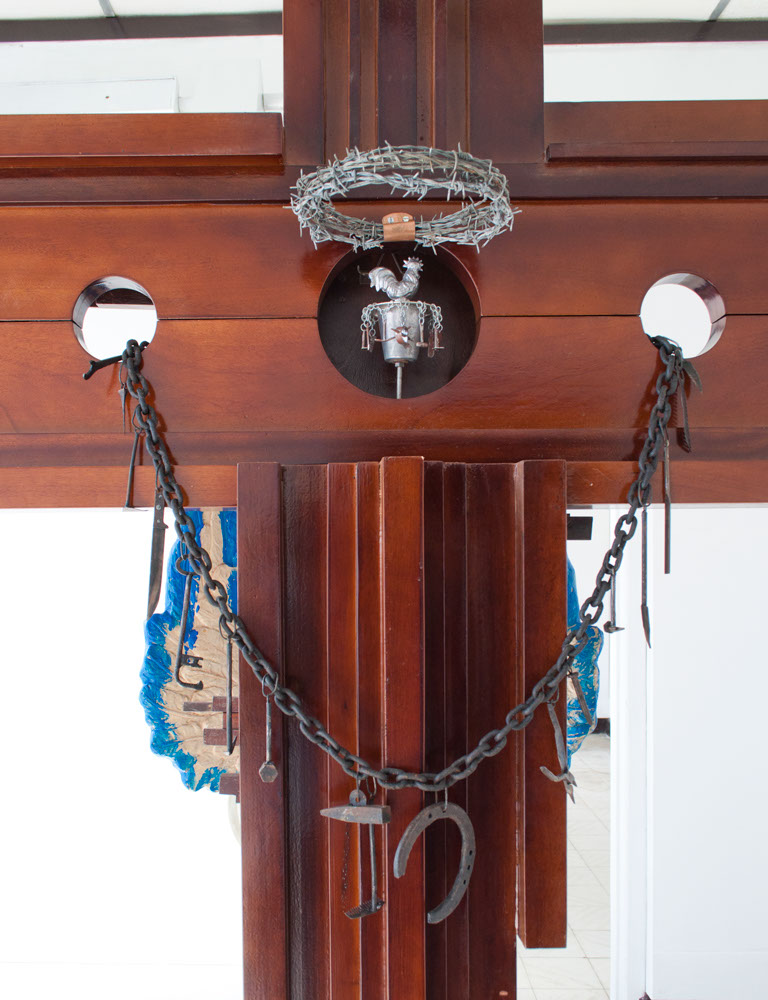
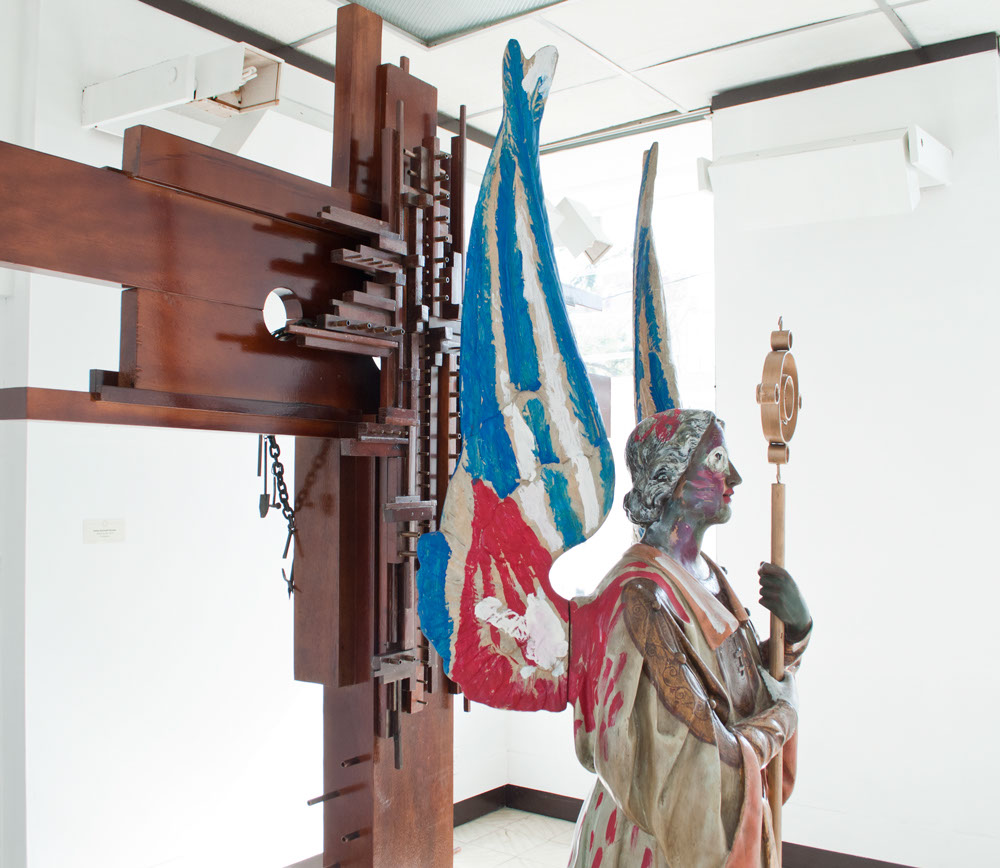
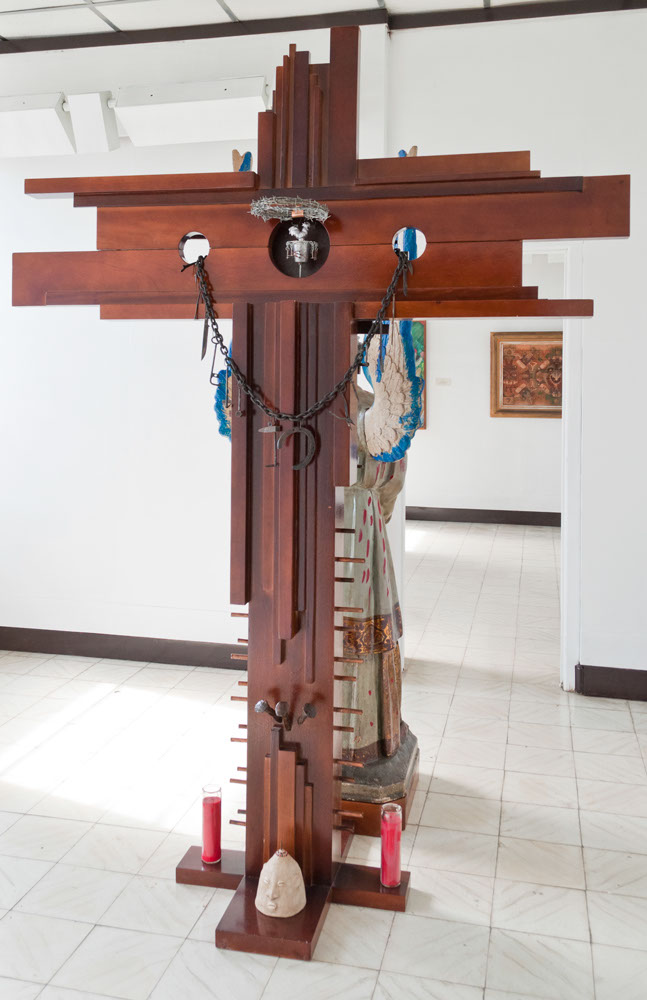








Lorem ipsum dolor sit amet.2
Lorem ipsum dolor sit amet.3
Lorem ipsum dolor sit amet.4
Lorem ipsum dolor sit amet.6
Lorem ipsum dolor sit amet.7
Lorem ipsum dolor sit amet.8
Resurrección, wood and copper / madera y cobre, 131.5 x 79.5 x 8 cm, 2002
“¿Perspectivas? Seguir profundizando en los estudios de la cultura afrocubana para que sea más entendida por el pueblo”
Rafael Queneditt Morales, 1973
...”uso mi arte para comunicar mi cultura e identidad cubanas,
que han sido influenciadas fuertemente por mi herencia africana.”
Rafael Queneditt Morales, 1989
(La Habana, 1942). Siguiendo una trayectoria personal de gran vitalidad, Queneditt ha conocido muy de cerca diversos estratos del ambiente cultural cubano, desde los contextos académicos que propiciaron su aproximación al quehacer artístico, hasta espacios y formas de la cultura popular que han dejado huellas indelebles en su obra. Formado en la Academia de Bellas Artes San Alejandro, en la especialidad de escultura y grabado, Queneditt tuvo un acceso privilegiado al mundo de la historia de Cuba, así como a otros aspectos medulares de la cultura debido a su labor en la Academia de Ciencias de Cuba y el Archivo Nacional de Cuba (ANC).
“Perspectives? To dig deeper into the study of Afro-Cuban culture so that it will be better understood by the people.”
Rafael Queneditt Morales, 1973
... “I use my art to communicate my Cuban culture and identity, which have been strongly influenced by my African heritage. ”
Rafael Queneditt Morales, 1989
(Havana, 1942). Throughout a career marked with great vitality, Queneditt has come to know well the various layers of the Cuban cultural scene, from academic contexts that led him into artistic activity to places and forms of popular culture that have left an indelible mark on his work. He studied at the San Alejandro Academy of Fine Arts with specialties in sculpture and
printmaking. His work in the Cuban Academy of Sciences and the Cuban National Archive gave him special access to the world of Cuban history, as well as other core aspects of culture.
ALBERTO LESCAY
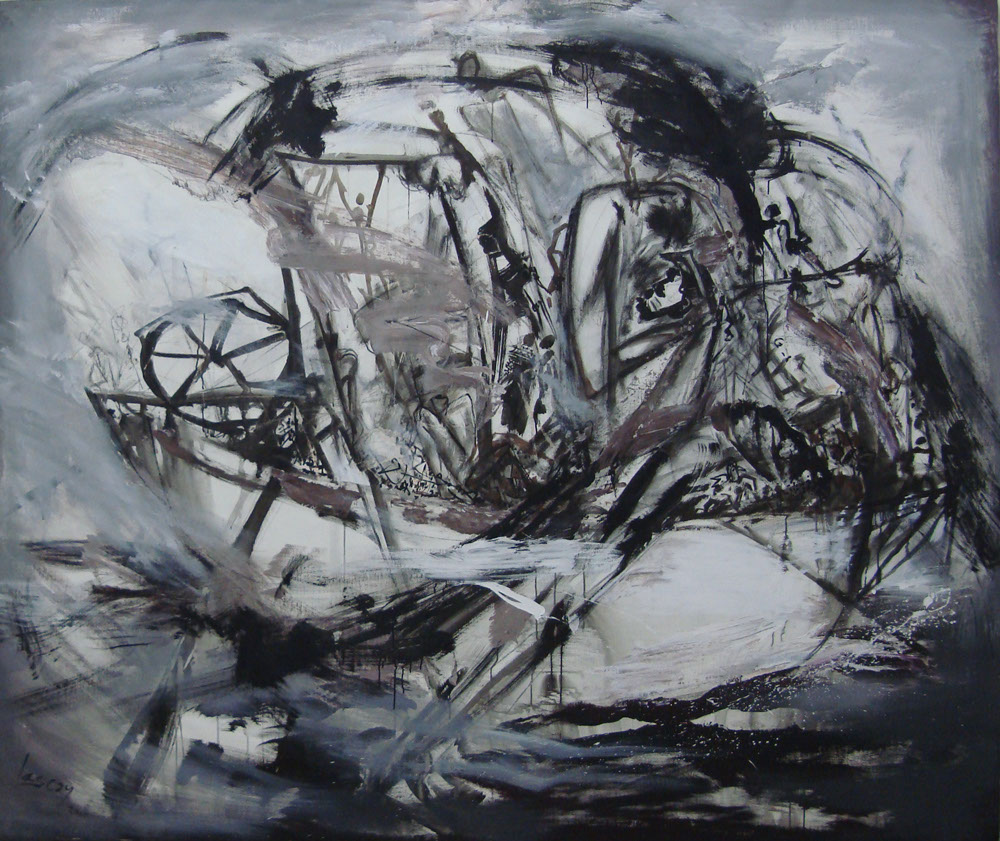
Serie Nganga, mixed on canvas / mixta sobre tela, 200 x 200 cm, 2010
Estudió en la Escuela de Artes Plásticas de Cubanacán y posteriormente se graduó en la especialidad de escultura en Academia de Bellas Artes Repin, en la antigua Unión Soviética. Una vez graduado regresó a su ciudad natal y se vinculó a instituciones como la Dirección de Artes Plásticas y Diseño del Ministerio de Cultura. En 1978 comenzó a dirigir el Taller Cultural Santiago.
Inicia su labor plástica en el Taller Cultural con exposiciones de dibujo, pintura y ensamblajes escultóricos. Paralelamente dirigió la actividad de esta institución, organizando encuentros culturales y conversatorios con artistas de las artes plásticas provenientes de distintas provincias del país.
(Santiago de Cuba, 1950) studied in the School of Fine Arts in Cubanacán, and later graduated with a specialization in sculpture from the Repin Academy of Fine Art, former Soviet Union. Upon graduation he returned to his native country and joined such institutions as the Directorate of Fine Arts and Design of the Ministry of Culture. In 1978 he became the director of the Santiago Cultural Workshop.
He began his work in the Cultural Workshop with exhibitions of drawing, painting, and sculptural assemblages. At the same time he directed the activities of the Workshop, organizing cultural meetings and interactions among visual artists from various provinces of the country. In these events the artists produced sculptures, ceramics, assemblages, and paintings that were later exhibited in the Cultural Workshop galleries.
DOUGLAS PEREZ
(b. 1972 Cuba) graduado del Instituto Superior de Arte en 1996, donde también trabajó como profesor de pintura. Ha expuesto su obra en numerosas exposiciones personales en
Cuba, incluyendo la Galería Servando, La Habana (2007). Ha expuesto internacionalmente en la Gallery Metis-NL, Amsterdam (2006) y Galería Berini, Barcelona (1998). Ha participado en numerosas exposiciones colectivas, como Without Masks, Johannesburg Art Gallery (2010); la Bienal de la Habana (2006); y Artists of the Caribbean, Contemporary Art Center, Rotterdam (2001). Douglas participó en Queloides I (1997), Ni Músicos ni Deportistas, Queloides II (1999), Without Masks (Johannesburg
Art Gallery, 2010) y Queloides: Race and Racism in Cuban Contemporary
Art (2010-12).
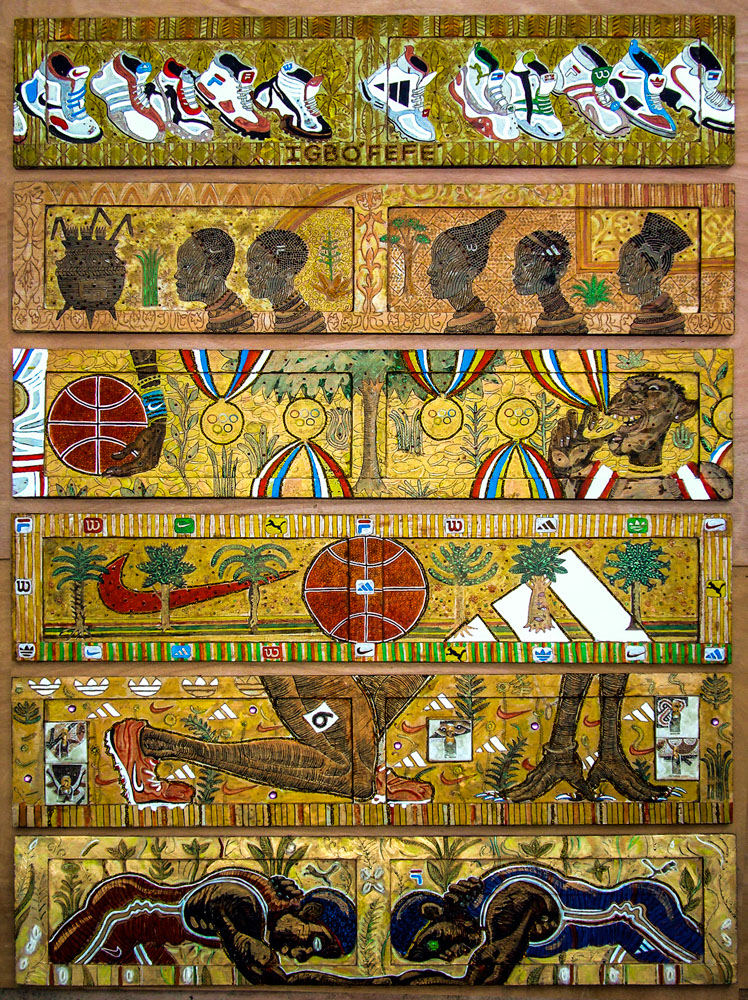
El jardín del alardoso (igbofefe), mixed on wood / mixta sobre madera, variable size / dimensión variable, 2012
(b. 1972) graduated from the Instituto Superior de Arte in 1996, where he was also a professor of painting. He
has exhibited his work in many solo exhibitions in Cuba, including
Galería Servando, Havana (2007). He has exhibited his work internationally at the Gallery Metis-NL, Amsterdam (2006); and the Galería Berini, Barcelona (1998). Group exhibitions include Without Masks, Johannesburg Art Gallery (2010); the Havana
Biennial (2006); and Artists of the Caribbean, Contemporary Art Center, Rotterdam (2001). Douglas participated in Queloides I (1997), Ni Músicos ni Deportistas, Queloides II (1999) and in Queloides: Race and Racism in Cuban Contemporary Art (2010-12).
OSCAR RODRIGUEZ LASSERIA
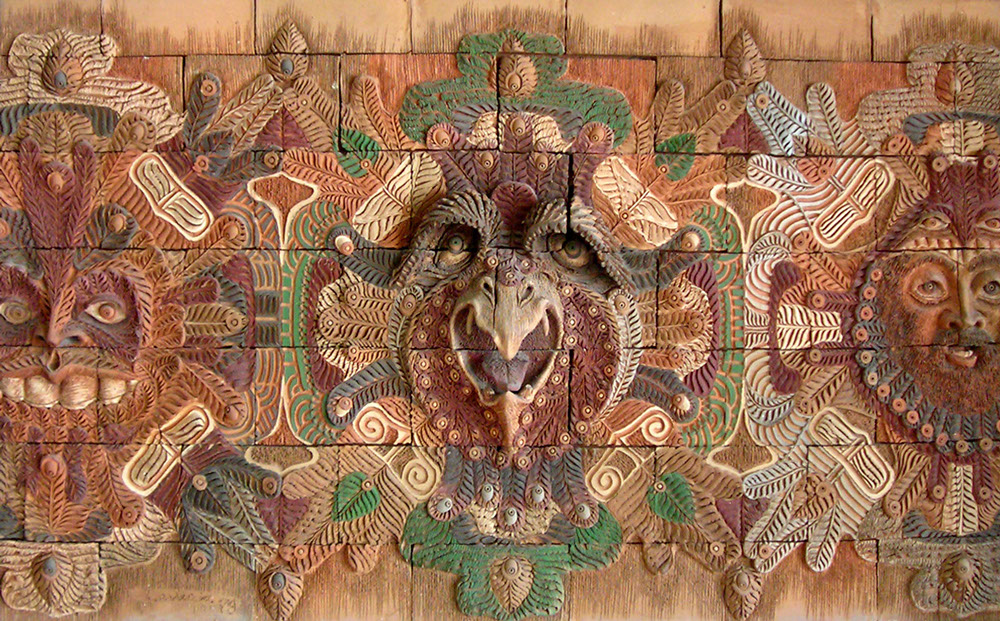
Montacongo, clay, engobe / cerámica policromada, engobe, 63 x 103 cm, 1973
(Florida, Camagüey, 1950). Realizó estudios en la Escuela de Artes Plásticas de Camagüey y en la Escuela Nacional de Instructores de Arte. Es graduado de la Academia Interamericana, Estados Unidos, en las especialidades de dibujo y pintura. Su obra en la creación cerámica ha conseguido consolidar un estilo propio, apoyado por quien ha sido su profesor y amigo, el artista Nazario Salazar.
Lasseria ha trabajado la pintura, la cerámica en las formas tradicionales, ha realizado murales cerámicos y ha creado obras en la técnica japonesa del Raku, que en Camagüey ha sido adaptada a las condiciones técnicas y a las peculiaridades del barro. Recientemente, Rodríguez Lasseria ha sido uno de los organizadores del VIII Simposio Internacional de Cerámica Artística, Puerto Príncipe 2012, en el que se realizaron obras en distintas técnicas cerámicas, que contó con la participación de creadores del arte del barro y el fuego provenientes de distintas regiones del país.
Guillermina Ramos Cruz, 2012
(Florida, Camagüey, 1950) studied at the School of Art of Camagüey and the Nation- al School for Art Instructors. He is a graduate of the Interamerican Academy in the United States with specialties in drawing and painting. His work in ceramic art has succeeded in consolidating a personal style, supported by his friend and teacher, the artist Nazario Salazar.
Lasseria has worked in painting, ceramics in traditional forms, and has made ceramic murals and articles in the Japanese technique of Raku, which in Camagüey has been adapted to the technical conditions and the particularity of the available clay. Recently Rodríguez Lasseria was one of the organizers of the VIII International Symposium of Artistic Ceramics in Puerto Principe in 2012, in which works were made with various ceramic techniques, with the participation of artists in clay and fire from several regions of the country.
Guillermina Ramos Cruz, 2012
RENE DE JESUS PEÑA
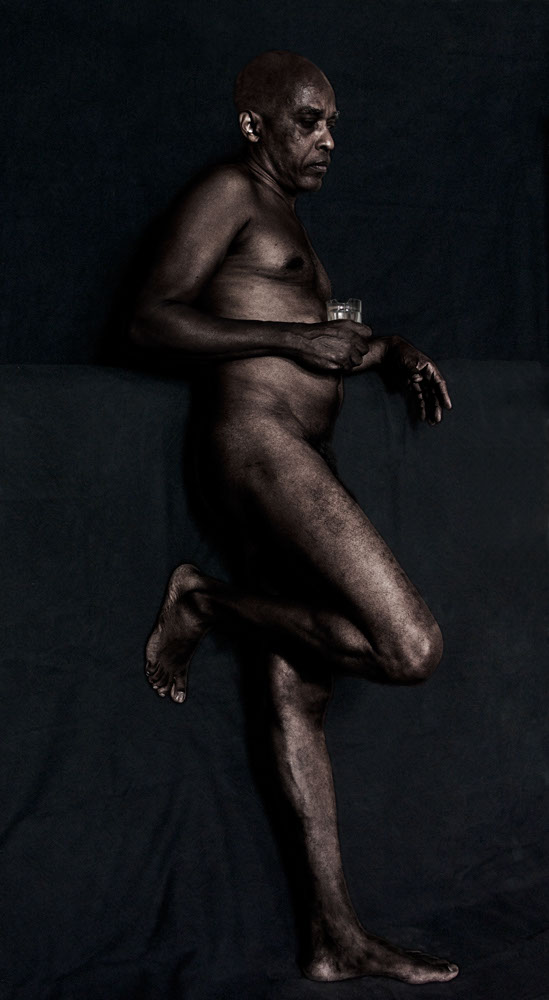
Untitled / Sin título, digital inkjet print / digital en inkjet, 133 x 100 cm, 2012
(b. 1957 Cuba) licenciado en lengua inglesa de la Universidad de la Habana. Además de numerosas exposiciones personales en Cuba, ha expuesto su obra en Galería Santa Fe, Bogotá (2008); Galería C-5, Santiago de Compostela (2007); Intemporel Gallery, Paris (2004); Diana Lowenstein Gallery, Miami
(2003); Casa de los Tiros, Granada (2002); y Suyama Space, Seattle. Las exposiciones colectivas incluyen la Octava Bienal de la Habana; Cuba! Art and History from 1868 to the present, Museum of Fine Arts, Montreal (2008); Lehigh University Art Gallery, Pennsylvania; y University Art Museum, SUNY Albany. Peña participó en Queloides I (1997), Ni Músicos ni Deportistas, Queloides II (1999), Without Masks (Johannesburg Art Gallery, 2010) y Queloides: Race and Racism in Cuban Contemporary Art (2010-12).
(b. 1957) graduated from the University of Havana with a specialization in languages. In addition to numerous exhibitions in Cuba, he has had solo exhibitions at Santa Fe Gallery, Bogota (2008); C-5 Gallery, Santiago de Compostela, Spain (2007); Intemporel Gallery, Paris (2004); Diana Lowenstein Gallery, Miami (2003); Casa de los Tiros, Granada, Spain (2002); and Suyama Space, Seattle. Group exhibitions include Havana Biennial VIII; Cuba! Art and History from 1868 to the present, Museum of Fine Arts, Montreal, Canada (2008); and at Lehigh
University Art Gallery, Pennsylvania; and University Art Museum, SUNY Albany. Peña participated in Queloides I (1997), Ni Músicos ni Deportistas, and Queloides II (1999). Recent exhibits include Without Masks (Johannesburg Art Gallery, 2010), and Queloides:
Race and Racism in Cuban Contemporary Art (2010-12).
CLARA MORERA
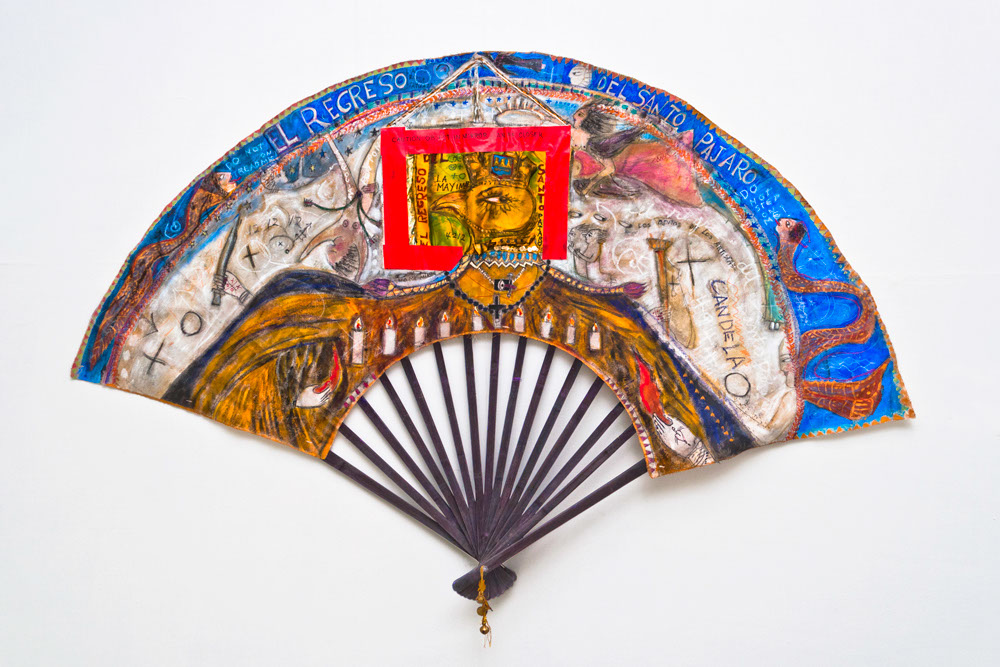
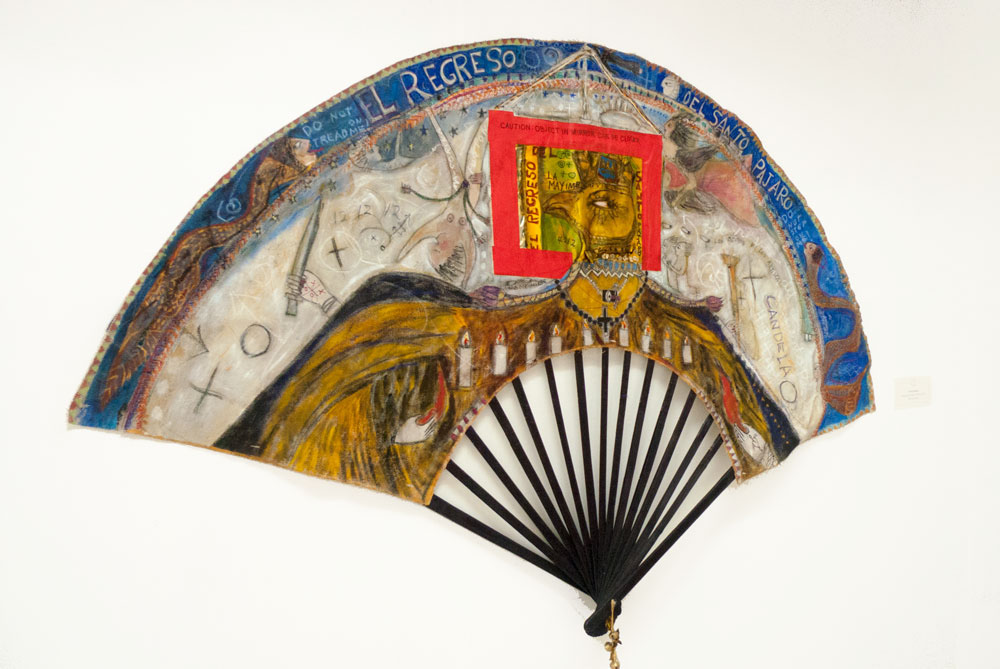


Clarita empieza por los orígenes; con un mundo caótico y promiscuo. Su primera exposición es una semilla: un pequeño caos que busca su equilibrio entre la pintura primitiva y occidental, entre los símbolos y los valores plásticos, entre lo blanco y lo negro de la cultura cubana.
Es la pintura de una voluntad, a pesar de los obstáculos, escasez de materiales y espacio, formación rudimentaria y necesidad de expresión.
Una lucha con un material que se resiste y se entrega; una pintura violenta, caótica, elemental.
Edmundo Desnoes, 1969
Amo la pintura de Clara Morera, pintura a la vez violenta e innovadora, lírica y misteriosa, que muestra a todas luces las cosmogonías africanas, donde ella alterna la vitalidad y la presencia de los amaneceres.
Aimé Césaire, 1969
Clarita begins at the beginning, with a chaotic and promiscuous world. Her first exhibition is a seed, a small chaos looking for balance between primitive and western painting, between symbols and artistic values, between white and black in Cuban culture.
It is painting with a will, despite the obstacles, shortages of material and space, rudimentary training, and the need for expression.
A struggle with material that resists and submits; violent, chaotic, elemental painting.
Edmundo Desnoes, 1969
I love Clara Morera’s painting, which is violent and innovative, lyrical and mysterious. It clearly shows African cosmogonies, where she alternates the vitality and the presence of the early times.
Aimé Césaire, 1969
LEANDRO SOTO
(b. 1956) es graduado de la Escuela Nacional de Arte en La Habana y participó en la famosa exposición Volumen Uno en La Habana (1981). Un artista visual multidisciplinario
que combina la pintura con instalaciones y peformance, Soto ha
dedicado una buena parte de su quehacer artístico a cuestiones
relacionadas con prácticas culturales y religiosas Afrocubanas.
Ha participado en 162 exposiciones colectivas y en 91 exposiciones
individuales en museos, galerías y espacios alternativos en España, Canadá, Brasil, México, República Checa, Alemania, Perú, Japón, Nicaragua, Jamaica, Italia, Cuba, India y los Estados Unidos. Ha sido profesor y conferencista en varias universidades de Estados Unidos y el Caribe. Soto es también el curador
de la exposición Cafe: Cuban American Foremost Exhibits, que destaca el carácter transnacional del arte y la cultura cubanos.
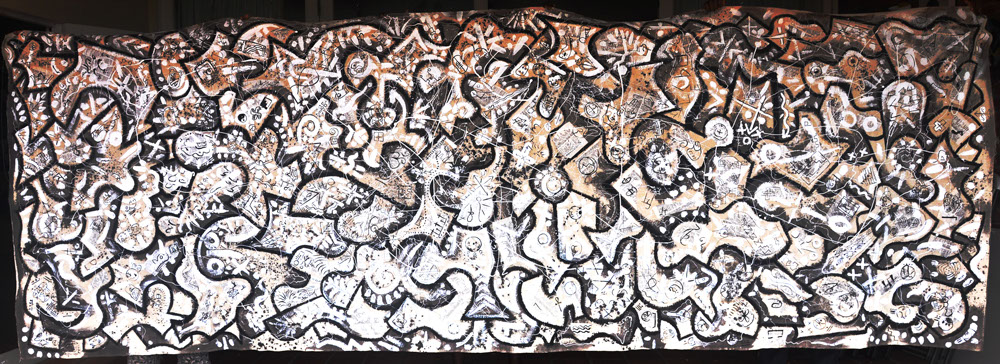
Obbatalá dibujando el mundo, mixed on canvas / mixta sobre lienzo, 157 x 462 cm, 2012
(b. 1956) graduated from the Escuela Nacional de Arte in Havana and participated in the famous Volumen Uno exhibit in Havana (1981). A multidisciplinary visual/installation
and performance artist, Soto has devoted much of his art to questions dealing with Afro-Cuban cultural and religious practices. He has participated in more than 162 group exhibitions and 91 solo art shows in museums, art galleries, and alternative art spaces in Spain, Canada, Brazil, Mexico, Czech Republic, Germany, Peru, Japan, Nicaragua, Jamaica, Italy, Cuba, India, and the United States. He has also taught at several universities in the United States and the Caribbean. Soto is also the curator of the traveling exhibit Cafe: Cuban American Foremost Exhibits, which highlights the transnational nature of Cuban art and culture.
MIGUEL DE JESUS OCEJO
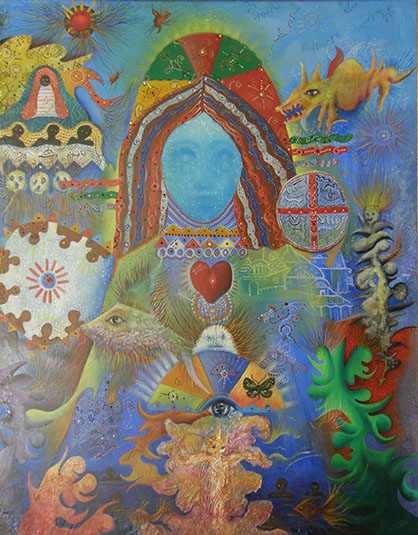
Ancestrálica de los fósiles, oil on canvas / óleo sobre tela, 119 x 94 cm, 1978
“Una de las raíces principa- les, la africana, por ejemplo, en nosotros está trabajada desde una visión de conjun- to. Se busca esa óptica que abarca e interpreta y que no siempre cuenta una anécdota, un dato específico. Y si usa- mos colores que pueden ser atributos distintivos de alguna deidad, están sumados a un hecho plástico donde vuela la imaginación para crear otra realidad.”
- Miguel Ocejo, 1974
Pintor y dibujante de for- mación autodidacta la obra pictórica de Miguel de Jesús Ocejo (Santiago de Cuba, 1940-La Habana, 2006) re- fleja las particularidades del entorno social y cultural donde na- ció y dio sus primeros pasos. Desde su pintura nos asomamos al panorama de la religiosidad popular oriental, caracterizado por elementos de los cultos de los primeros pobladores de nuestra Isla, por las referencias visuales próximas a las ceremonias de procedencia franco-haitianos y por elementos visuales múltiples del Espiritismo.
Guillermina Ramos Cruz, 2012
“One of our main roots, the African, for example, is considered from a holistic perspective. I’m looking for that point of view that is all encompassing and interprets, rather than recounting an anecdote, or a specific fact. And if we use colors that might be distinctive attributes of a deity, they are added to a work of art in which the imagination soars to create another reality.”
Miguel Ocejo, 1974
The painting of self-taught artist Miguel de Jesús Ocejo (Santiago de Cuba, 1940-Havana, 2006) reflects the particular social and cultural environment he was born into and where he took his first steps. In his paintings we see the panorama of the popular religions of eastern Cuba, characterized by elements of the cults of the first inhabitants of our is- land, visual references derived from Franco- Haitian ceremonies, and by multiple visual elements of spiritism.
Guillermina Ramos Cruz, 2012
ANDRES MONTALVAN CUELLAR
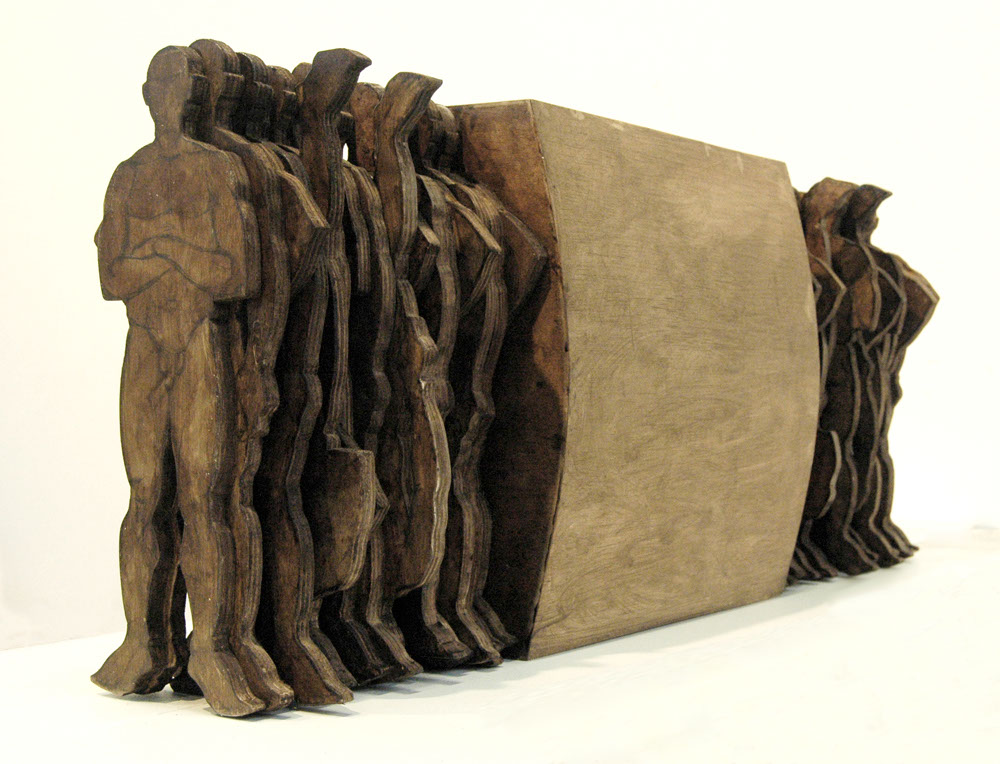
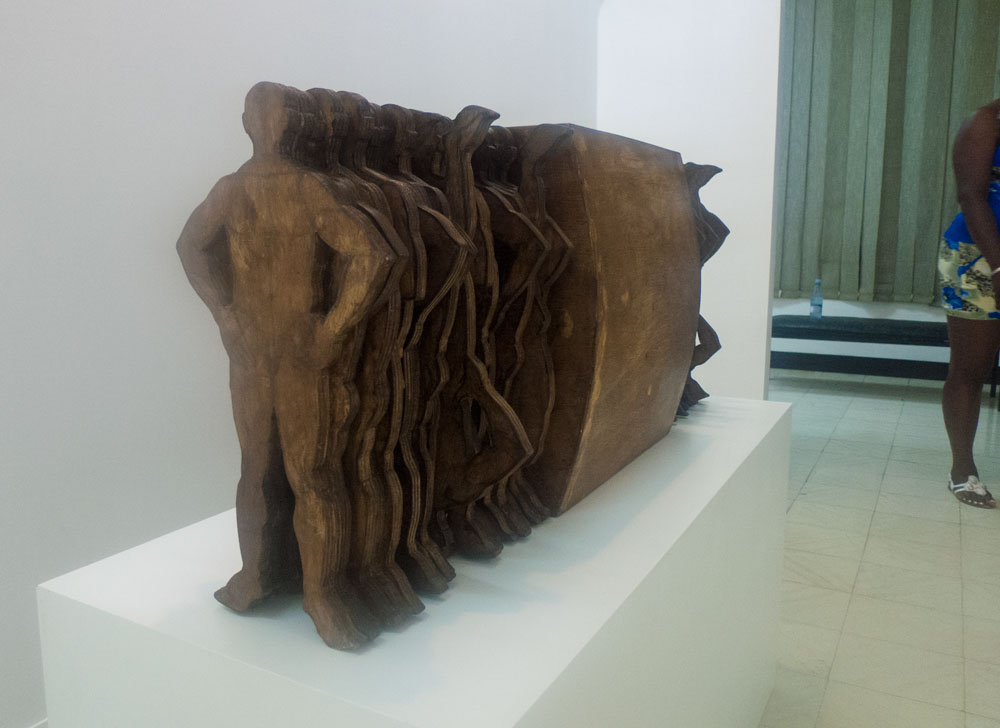
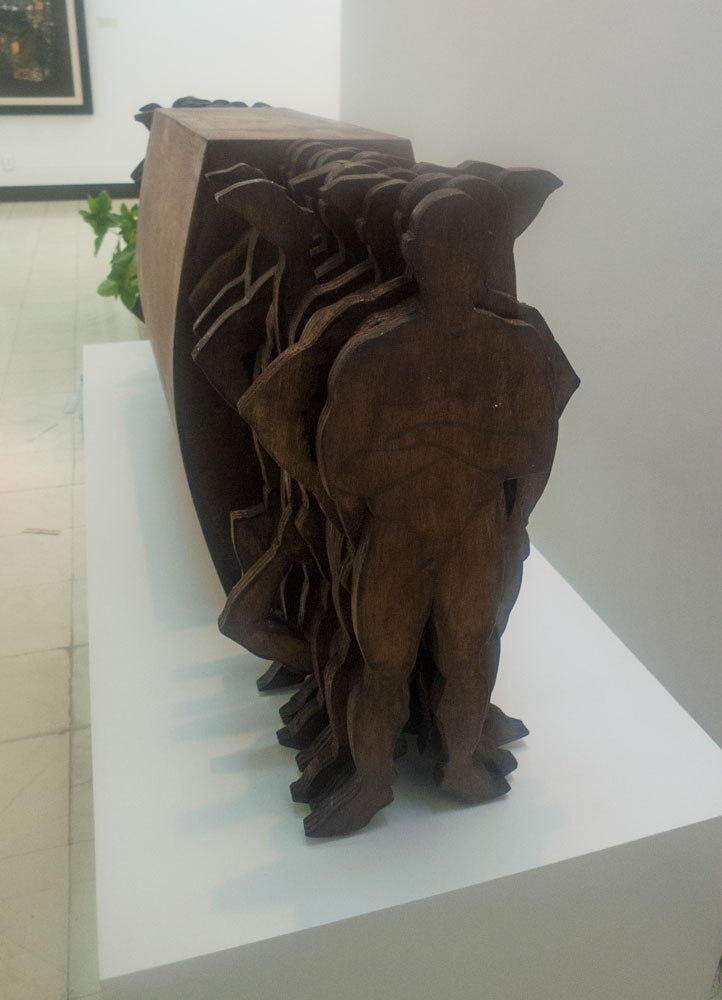
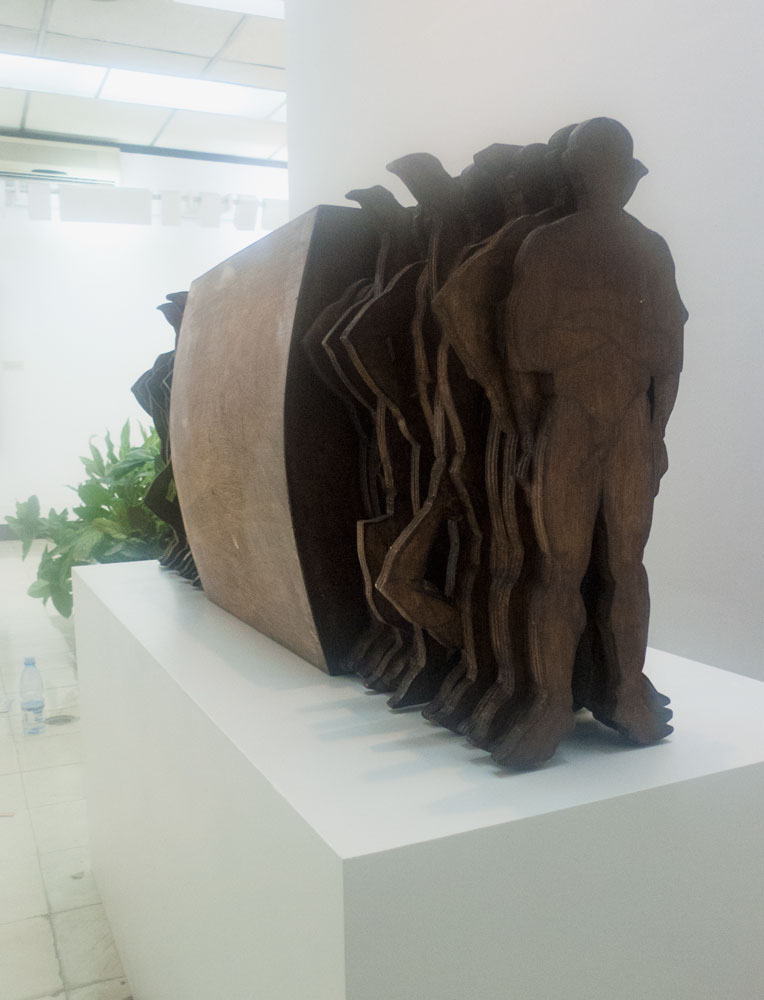




Eterna idea del regreso, wood / madera, 50 x 120 x 40 cm, 2012. “A mi padre gracias eternas por estar hasta tu último momento.”
Lorem ipsum dolor sit amet.3
Lorem ipsum dolor sit amet.5
Lorem ipsum dolor sit amet.6
(b. 1966) graduated from the Academia
de Arte de San Alejandro in 1985. In 2000 he was an artist in residence at the Sumei Multidisciplinary Arts Center, Newark and in 2001 at Florida Atlantic University, Boca Ratón, Florida. Among his most important solo exhibits are La memoire dans la peau at Galería La Casona, Havana (2010), Correspondencias (La Passerelle L’IUFM Haute, Normandie, France, 2008) and El dolor de la existencia, Centro de Desarrollo de las artes visuales, Havana (1999). He has participated in collective exhibits in Cuba, Spain, Panama, the United States, including the 10th Havana Biennial. Montalván also participated in Queloides II (1999).
(b. 1966) es graduado de la Academia de Arte de San Alejandro en 1985. En el 2000 fue artista en residencia en el Sumei Multidisciplinary Arts Center, Newark y en el 2001 en Florida Atlantic University, Boca Ratón, Florida. Entre sus exposiciones individuales más importantes se hallan La memoire dans la peau en Galería La Casona, La Habana (2010), Correspondencias (La Passerelle L’IUFM Haute, Normandie, France, 2008) y El dolor de la existencia, Centro de Desarrollo de las artes visuales, La Habana (1999). Ha participado en exposiciones colectivas en Cuba, España, Panamá, y los Estados Unidos, incluyendo la Décima Bienal de La Habana. Montalván también participó en Queloides II (1999)
ELIO RODRIGUEZ VALDES
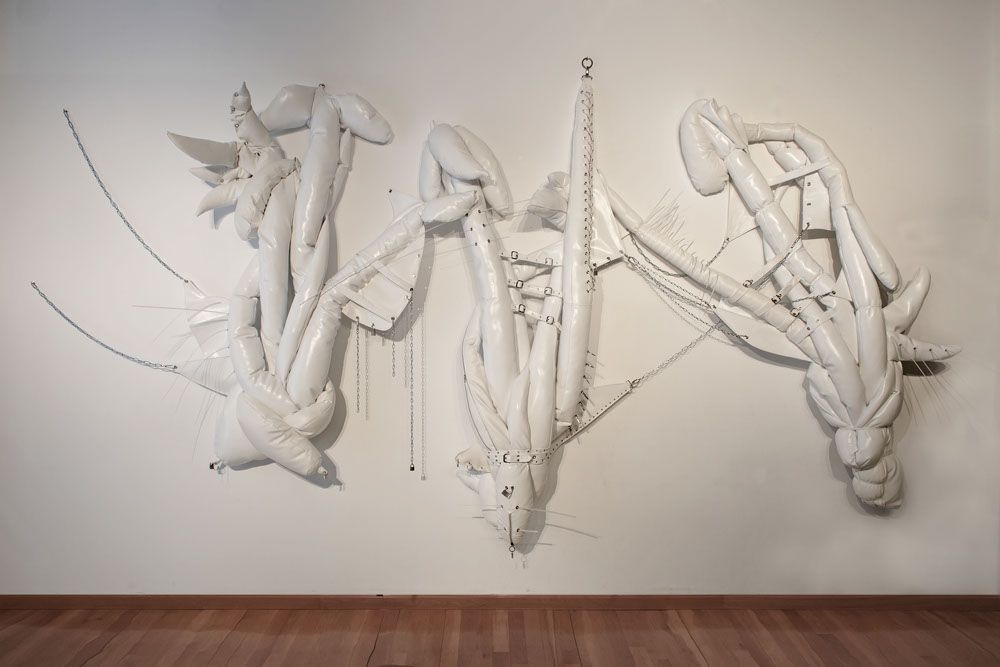

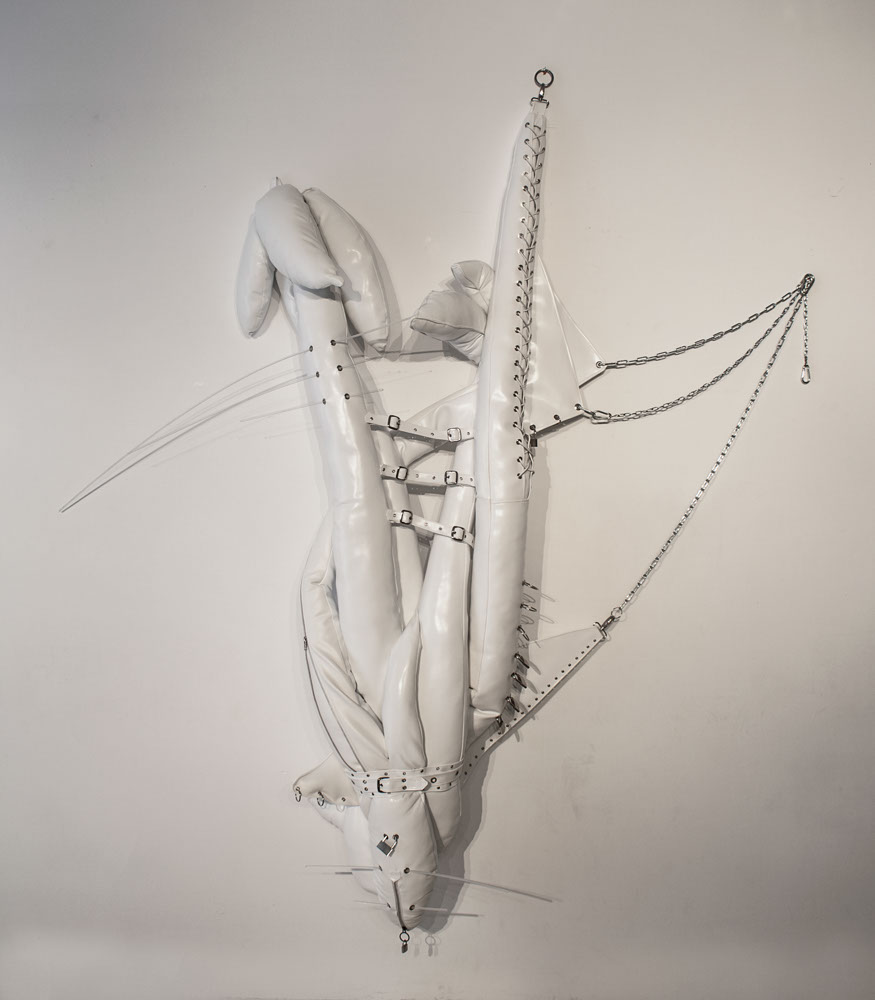





serie Selva en las Paredes, installation, soft sculpture (leather, chains, padlocks) / instalación escultura blanda (piel, cadenas, candados), 250 x 500 x 20 cm, 2012
Selva en las Paredes #1, installation, soft sculpture (leather, chains, padlocks) / instalación escultura blanda (piel, cadenas, candados), 250 x 500 x 20 cm, 2012
Selva en las Paredes #2, installation, soft sculpture (leather, chains, padlocks) / instalación escultura blanda (piel, cadenas, candados), 250 x 500 x 20 cm, 2012
Selva en las Paredes #3, installation, soft sculpture (leather, chains, padlocks) / instalación escultura blanda (piel, cadenas, candados), 250 x 500 x 20 cm, 2012
(b. 1966) graduated from Instituto Superior de Arte in 1989 and has exhibited his prints and soft sculptures throughout the world, including at the Centro de Arte Contemporáneo, Elche, Spain (2009); the University of Pittsburgh Frick
Fine Arts Gallery (2007) and at the Cervantes Institute in London (2006). He has exhibited extensively in Cuba, including the Havana Biennial. Elio has been a visiting artist at Tufts University and Harvard University, Boston; and in Buffalo, New York. Elio
participated in Queloides I (1997), Ni Músicos ni Deportistas, and Queloides II (1999), and Without Masks (Johannesburg Art Gallery, 2010). He co-curated Queloides: Race and Racism in Cuban Contemporary Art (2010-12).
(b. 1966 Cuba) graduado del Instituto Superior de Arte en 1989. Ha expuesto sus grabados y esculturas blandas alrededor del mundo, incluyendo el Centro de Arte Contemporáneo, Elche, España (2009); la Frick Fine Arts Gallery de University of Pittsburgh (2007) y el Instituto Cervantes de Londres (2006). Ha expuesto con frecuencia en Cuba, incluyendo las Bienales de la Habana. Elio ha sido artista invitado en Tufts University, en Harvard University y en University of Buffalo, Nueva York. Participó en Queloides I (1997), Ni Músicos ni Deportistas, Queloides II (1999) y Without Masks (Johannesburg Art Gallery, 2010). Fue co-curador de Queloides: Race and Racism in Cuban Contemporary Art (2010-12).

JULIA VALDÉS
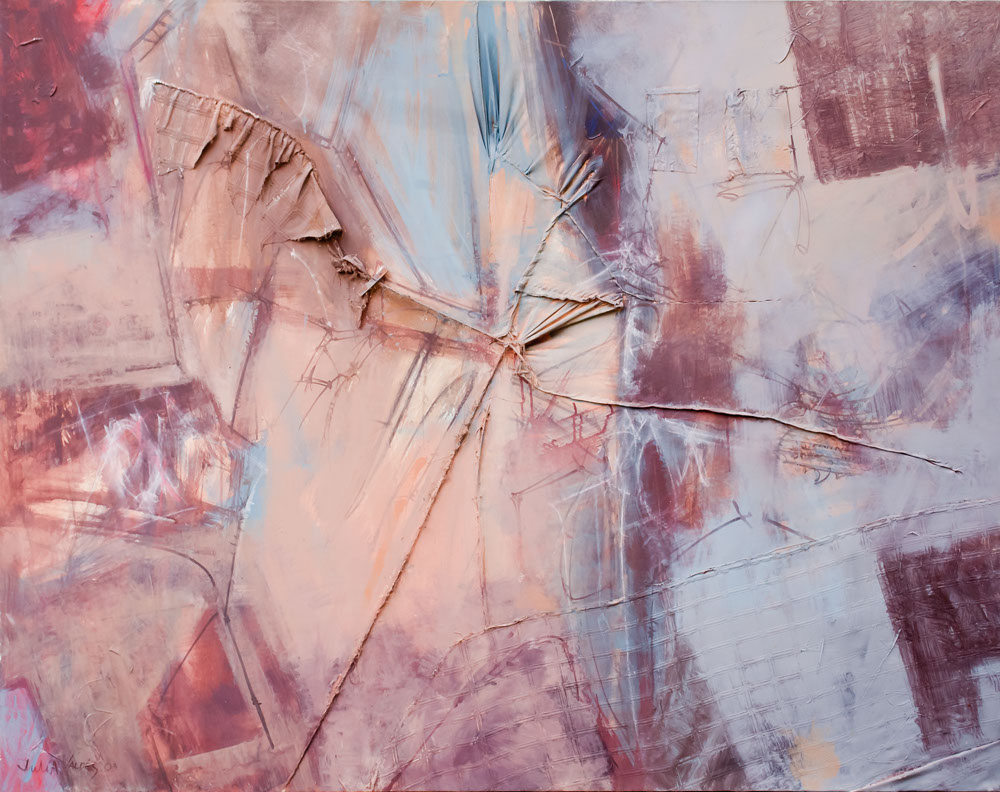
Serie Interiores de La Habana Vieja, mixed and acrylic on canvas / mixta y acrílico sobre tela, 140 x 180 cm, 2003
Ilustrar el camino recorrido por Julia Valdés llevaría a sopesar su inicial oscilación entre lo figurativo y lo abstracto, las funciones del dibujo a lo largo de su desempeño artístico; de un rol casi esencial hacia un desempeño subordinado en su insinuación tras las manchas, en sus derredores o en su tímida aparición en el interior de las veladuras, en tanto su paleta cambiaba el rumbo de sus preferencias cromáticas o se iba en pos de asuntos que fueron sus motivaciones. Esta ruta – que en algún momento deberá ser reconstruida – entraría a dirimir el ritmo ascendente de su discurso, precisando las etapas que conforman el conjunto de su obra, acción que escapa a esta crónica cuyo destino resulta una posible lectura de su producción mas reciente.
Caridad Blanco de la Cruz, 2011
Illustrating the path Julia Valdés has taken would involve weighing her initial oscillation between the representational and the abstract, and how drawing has functioned in the course of her artistic career: from an almost essential role moving to a subordinate function by being inserted into spots, on the perimeter, or timidly appearing within concealed spaces, as her palette changed the course of her chromatic preferences or were subordinated to other topics that came to motivate her. That trajectory—which should be reconstructed sometime—came to show the ascendant rhythm of her discourse, indicating the stages of her work as a whole. Such a task is beyond the scope of this chronicle, the purpose of which is to provide a possible way of interpreting her more recent production.
Caridad Blanco de la Cruz, 2011
LEONEL MORALES

Leonel con sus realizaciones del panteón de la liturgia de la regla de Ocha o Santería asocia la belleza con la armonía de la fisonomía con la brillantez de una composición a la usanza medieval catalana y el arte naif del país de los yorubas. Sus elementos rituales que los distinguen: las estrellas y los cuatros vientos de Oya, la voluntariosa y guerrera, en su multicolor mundo de la floración, armada de flechas, venados y tigres, en gamas de ocres, verdes de Ochosi, el cazador desdoblamiento de Oggún el guerrero; de Elegguá con güiros, juguetes, trompos y papalotes, incansable niño de los destinos; Changó guerrero, amante, con su Oché, su caballo, sus palmas, rodeado, en el rojo y blanco, de sus amores eternos: Oya, Ochun y Obba.
Natalia Bolívar, 2000
Leonel with his embodiments of the pantheon of the liturgy of the Regla de Ocha or Santería associates beauty with harmony of the physiognomy with the brilliance of composition in the style of medieval Catalan art and the naive art of the land of the Yorubas. These are the ritual elements that distinguish them: the stars and the four winds of Oya, the willful warrior in her multicolor flowering world, armed with arrows, deer and tigers in shades of ocher; the greens of Ochosi, the hunter, paired with Oggún, the warrior; Elegguá with gourds, toys, tops, kites, the tireless child of the fates; Changó the warrior, lover with his Oché thunder axes, horse, palm fronds, surrounded in red and white by his eternal loves—Oya, Ochún, and Obba.
Natalia Bolívar, 2000
x
desktop view
proyecto y curaduría:/project concept and curator: Alejandro de la Fuente
web design: Los Fieras
Agradecemos a la Fundación Ford por su apoyo para este proyecto /
/ Thanks to Ford Foundation for their support for this project"



